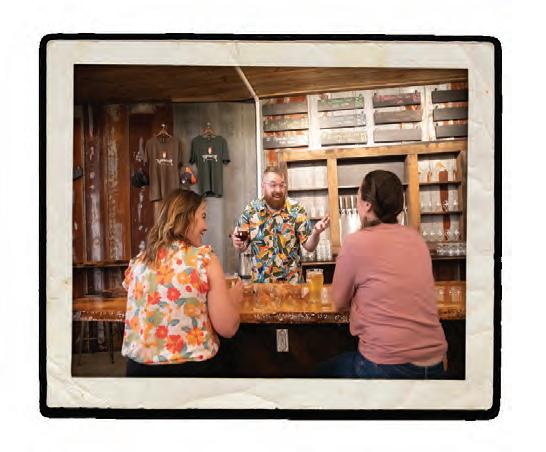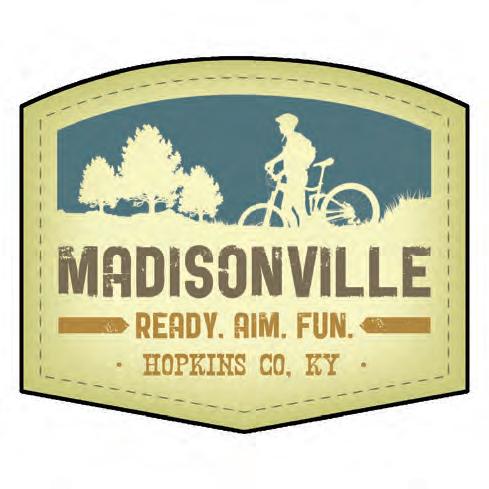with Kentucky Explorer

Mansions

with Kentucky Explorer

Mansions
Country star Chris Stapleton and Buffalo Trace represent a celebrity and bourbon collaboration
Director Teddy Abrams LEX Studios Opens Performing Arts Season Begins

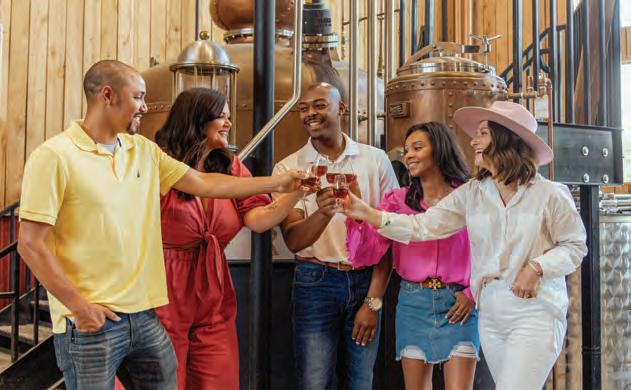

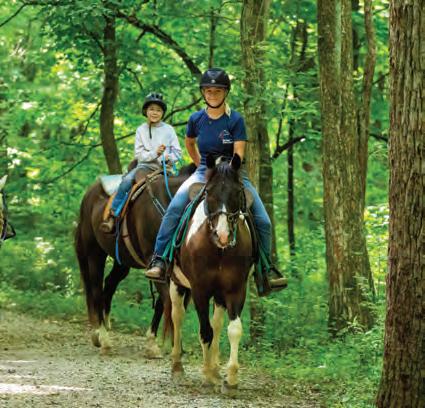
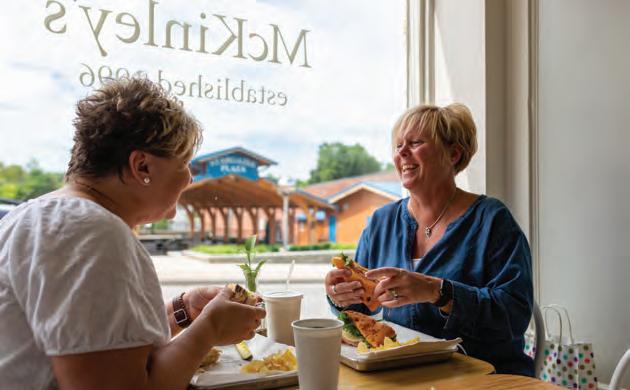

Start planning at visitshelbyky.com.

12 Stars and Spirits

30 In Harmony
Director Teddy Abrams finds creative ways to share the Louisville Orchestra’s music throughout the city and across the Commonwealth
35 Hooray for Lexington! With LEX Studios, Misdee Wrigley Miller has a vision to put Kentucky on the film production map
42 Shows by the Dozen Kentucky’s 2024-2025 performing arts season presents a packed roster of a variety of shows
Test your knowledge of our beloved Commonwealth. To find out how you fared, see page 6.
1. While Kentucky bluegrass is a common surface for baseball fields, how many NFL teams play on it?
A. 4
B. 6
C. 8
2. What is the natural height for Kentucky bluegrass?
A. 4-6 inches
B. 3-5 feet
C. 5 feet, 8 inches
3. Pikeville’s Ryan Hall, Y’all, a popular internet personality, livestreamed for the first time during what event?
A. University of Kentucky-Mississippi State University basketball game
B. A tornado outbreak
C. A political rally
4. Madison Paige Lilley, a 5-foot-11 athlete who committed to the University of Kentucky in high school. In 2021, Lilley was named the top female athlete in the Southeastern Conference, which was noteworthy because she was the first what to earn that distinction?
A. Left-handed player
B. Gymnast
C. Volleyball player
5. The Kentucky wildcat (not the costumed version) lives where?
A. A fenced compound between the stadium and the KET building
B. The Salato Wildlife Education Center near Frankfort
C. Camp Wildcat in Laurel County
6. Actor Steve Zahn met his wife, Robyn, while performing in a tour of Bye Bye Birdie and settled in Lexington near her father. Who is her father?
A. Horse trainer Frank Heffley
B. Former UK football coach Bill Curry
C. Clothier J. Peterman
7. John Peterman, fictionalized in the TV series Seinfeld, first struck entrepreneur gold selling which Kentucky product?
A. Hall’s Snappy Beer Cheese
B. Laura’s Lean Beef
C. Mingua Beef Jerky
8. Corbin’s Reba Jeanette Smith (aka Debbie Dean, Penny Smith and Debbie Stevens) was a well-known figure in the 1950s and ’60s for what reason?
A. She was a notorious bank robber, thus the numerous aliases
B. She had at least four distinct personalities when she arrived at Bellevue Hospital in New York
C. She was the first white female singer signed by Berry Gordy at Motown Records
9. Traveling from the north, the line between the Eastern Time Zone and the Central Time Zone enters Kentucky and follows the county line between Breckinridge and Meade counties exiting Kentucky where?
A. The Cumberland River flowing south into Tennessee
B. The county line between Clinton and Wayne counties
C. Fred Gilbert’s property line east of Churntop and west of Hogback
10. Thirteen distilleries owned by eight companies produce more than 99 percent of all whiskey made in the United States. Of those 13, how many are in Kentucky?
A. 5
B. 7
C. 10

© 2024, VESTED INTEREST PUBLICATIONS
VOLUME TWENTY-SEVEN, ISSUE 7, SEPTEMBER 2024
Stephen M. Vest Publisher + Editor-in-Chief
Patricia Ranft Associate Editor
Rebecca Redding Creative Director
Deborah Kohl Kremer Assistant Editor
Ted Sloan Contributing Editor
Cait A. Smith Copy Editor
Jackie Hollenkamp Bentley, Jack Brammer, Bill Ellis, Steve Flairty, Gary Garth, Jessie Hendrix-Inman, Mick Jeffries, Kim Kobersmith, Brigitte Prather, Walt Reichert, Tracey Teo, Janine Washle and Gary P. West
CIRCULATION
Barbara Kay Vest Business Manager
Lindsey Collins Senior Account Executive and Coordinator
Kelley Burchell Account Executive
Laura Ray Account Executive
Teresa Revlett Account Executive For advertising information, call 888.329.0053 or 502.227.0053
KENTUCKY MONTHLY (ISSN 1542-0507) is published 10 times per year (monthly with combined December/ January and June/July issues) for $25 per year by Vested Interest Publications, Inc., 100 Consumer Lane, Frankfort, KY 40601. Periodicals Postage Paid at Frankfort, KY and at additional mailing offices.
POSTMASTER: Send address changes to KENTUCKY MONTHLY, P.O. Box 559, Frankfort, KY 40602-0559. Vested Interest Publications: Stephen M. Vest, president; Patricia Ranft, vice president; Barbara Kay Vest, secretary/treasurer. Board of directors: James W. Adams Jr., Dr. Gene Burch, Gregory N. Carnes, Barbara and Pete Chiericozzi, Kellee Dicks, Maj. Jack E. Dixon, Bruce and Peggy Dungan, Mary and Michael Embry, Judy M. Harris, Greg and Carrie Hawkins, Jan and John Higginbotham, Frank Martin, Bill Noel, Walter B. Norris, Kasia Pater, Dr. Mary Jo Ratliff, Randy and Rebecca Sandell, Kendall Carr Shelton and Ted M. Sloan.
Kentucky Monthly invites queries but accepts no responsibility for unsolicited material; submissions will not be returned. KENTUCKYMONTHLY.COM


I always read Kentucky Monthly from cover to cover. I live in Tennessee but always will be a Kentucky girl at heart.
I really enjoyed reading about Duncan Hines Days in Bowling Green (May issue, page 20). My grandchildren think I am an amazing cook because they love my brownies. My secret: Duncan Hines Brownie Mix!
Thanks and keep up the great work.
Carol Dillard, Elizabethtown native now living in Lebanon, Tennessee
Nicknames and Memories
I have enjoyed each and every one of Bill Ellis’ Kentucky Monthly articles!
They are especially interesting to me because I grew up in Eminence and spent a lot of time in Shelbyville.
My dad drove a gas truck for the WPB Oil Company, and I would go with my grandmother every Friday to the Steiden grocery store to do her weekly shopping. I was in a rock band with Van Hildreth, whose dad owned the Western Auto store on Main Street. We played many gigs at Saffell’s roller rink and other places in Shelbyville.
I married Dr. S.B. May’s daughter, Margaret, and went with him many times to the hospital in Shelbyville to watch him do his rounds. Heck, I think I even had a relative or two who lived on Snow Hill for a while.
Regarding Mr. Ellis’ column on names (August issue, page 57). When I was younger, my head may have been a little large for my body, so certain relatives got a big kick out of calling me “Head Boy” and “Box Head” as well as other nicknames not suitable for a nice magazine. It never really bothered me, but as I read that article, it took me back to those long-ago days. I knew my relatives loved me, and so, I would laugh right along with them.
Like Mr. Ellis, the names I am the proudest of are husband, dad, granddad and great-granddad. I am also proud of the name teacher, having taught in the Fayette County school system for 25 years.
Wayne Roberts, Georgetown
We Love to Hear from You! Kentucky Monthly welcomes letters from all readers. Email us your comments at editor@kentuckymonthly.com, send a letter through our website at kentuckymonthly.com, or message us on Facebook. Letters may be edited for clarification and brevity.


Kentucky Monthly’s annual gift guide highlights some of the finest handcrafted gifts and treats our Commonwealth has to

Even when you’re far away, you can take the spirit of your Kentucky home with you. And when you do, we want to see it!

Twenty-three Kentucky tourism professionals attended the Southeast Tourism Society in Macon. Pictured are Lynelle Morgan, Kelly Burton, Michelle Perry, Heather Cundiff, Hannah Medley, Jennifer Hagan, Jean Michalak, Jennifer McNett, Samantha Johnson and baby River, Linda Watts, Nicole Fitzpatrick, Katie Shea, Chris Robinson, Samantha Brady, Tina Woods, Landry Steenbergen, Candace Arnold, Colbi Ferguson, Brooke Jung, David Jones and Mason Warren
Not pictured are Liz Hammonds and Hannah Wallen

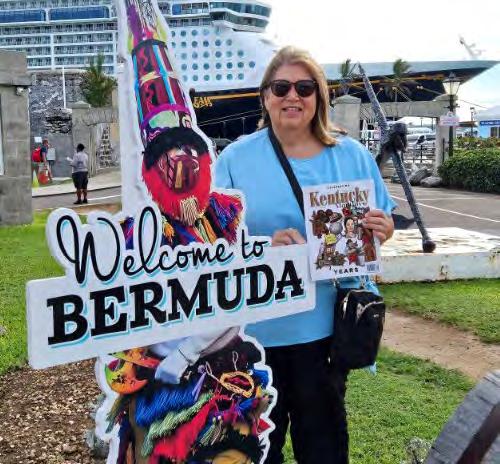
The beautiful resort community of French Lick West Baden, Indiana and neighboring towns of Orleans and Paoli have been welcoming guests on marvelous Indiana getaways for over 100 years — guests who have been searching for the perfect destination with gracious hospitality, ultimate luxury, and an unforgettable experience. Whether you’re seeking adventure or tranquility, there is something for everyone to discover.
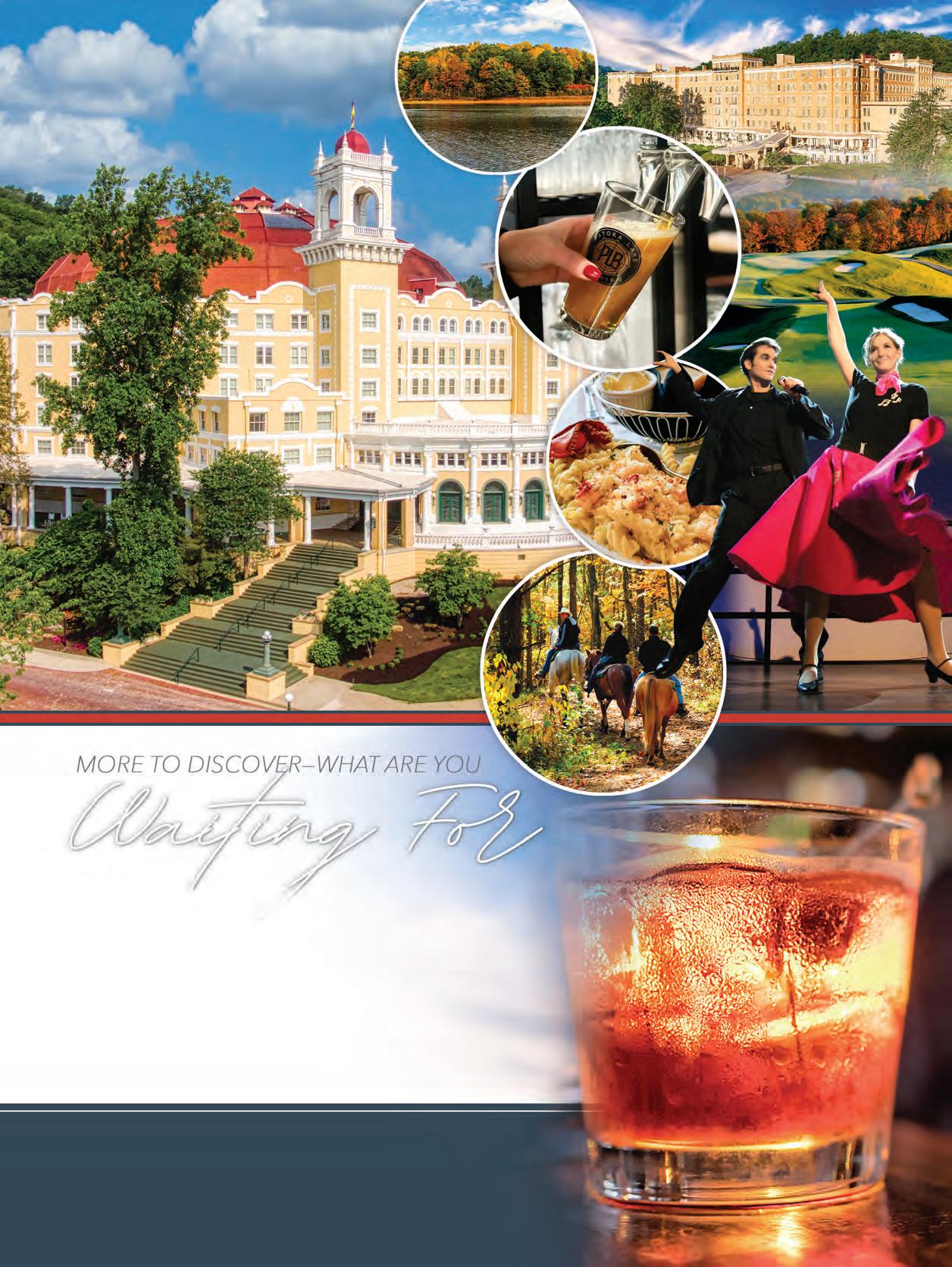



Morris Grubbs and Anissa Radford of Lexington soaked in the beauty of Sorrento, Italy. In the distance, across the Bay of Naples, is the still-active Mount Vesuvius, whose eruption in 79 AD buried the city of Pompeii.


Take a copy of the magazine with you and get snapping! Send your high-resolution photos (usually 1 MB or higher) to editor@kentuckymonthly.com or visit kentuckymonthly.com to submit your photo.
KWIZ ANSWERS
1. A. The Chicago Bears, Cleveland Browns, Denver Broncos and Pittsburgh Steelers; 2. B. The blue flower that gives the grass its name does not appear until after the plant reaches 3 feet; 3. B. The tornado outbreak of March 17, 2021; 4. C. Lilley also is an assistant volleyball coach; 5. B. While the elusive bobcat, the most common wildcat in North America, is abundant in the wild in our state, visitors can see two bobcats at the center; 6. C. Robyn Peterman is a best-selling author and writes a blog, robynpeterman.com; 7. A. Peterman partnered with Donald Staley and Winchester’s Hall’s on the River restaurant; 8. C. She co-wrote songs for The Supremes, The Temptations and The Four Tops during her three years at Motown; 9. B. About 60 percent of Kentucky is in the Eastern Time Zone; 10. C. The Commonwealth has a long, rich history of distilling whiskey.


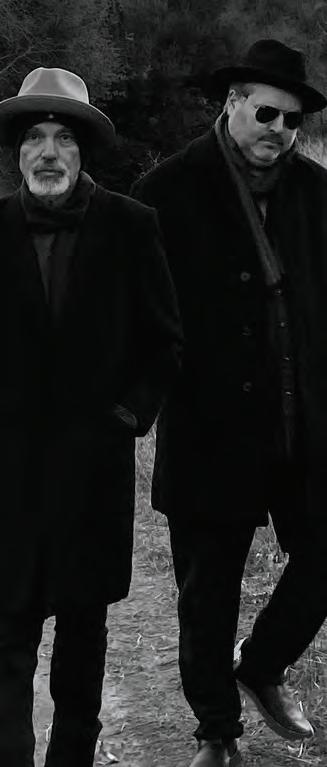

Anne Wilson grew up loving all things NASA. Her dream was to become an astronaut. But the 22-year-old Lexington native has come to believe that God had another plan for her.
Wilson is starting her first tour as a headliner. Her Christian country music album Rebel came out in April, and Sept. 12 will be her first show on the tour. She’ll start off in Tulsa, Oklahoma, and play 29 stops, including the Ryman Auditorium in Nashville on Sept. 25.
Wilson said she’ll play mostly theaters—venues that seat around 1,800. In June, she played a sold-out show at the Lexington Opera House. Wilson said it was a particularly special show for her because it was in her hometown. It also was June 12, the anniversary of her brother’s funeral. “It was a whole fullcircle moment for me,” she said.
forced all of us to play piano as kids,” Wilson said, so she knew some notes. It turned out her mother was home, heard her daughter singing, and was
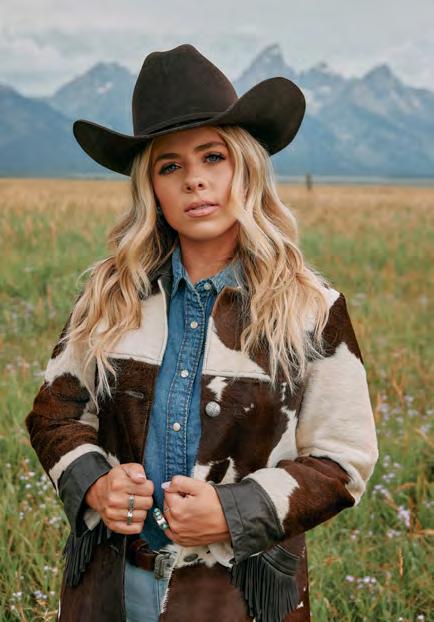
Wilson’s older brother, Jacob, was killed in a car accident in 2017. He was just 23. “He was the glue that held the family together,” Wilson said. There was no chance to say goodbye. “It was a big moment in my relationship with God. The feeling of hopelessness was so real.”
Wilson was 15 at the time. She had no musical aspirations, and she’d never sung in public. She’d barely sung in front of her family. She once sat at the family piano and sang, thinking she was home alone. “Mom
moved. She asked her to sing at Jacob’s funeral.
Wilson sang “What a Beautiful Name,” and the song went viral. “Slowly but surely, God started opening doors for me in music,” she said. After graduating from Veritas Christian Academy in Lexington, she headed to Nashville.
Wilson is clear on the sound and message she wants to convey. She said her music is “very country but all Christian lyrics and concepts.” It’s a combination she is comfortable
with, in spite of country music’s history of drinking and cheating songs. In fact, she addresses that in “Songs About Whiskey,” which was released to country radio on July 15, while her song “The Cross” was released to Christian radio on July 26.
The country/Christian combo is working, and Wilson has received awards for her sound. She received her first Grammy Award nomination for her 2022 album My Jesus, which was nominated for Best Contemporary Christian Music Album. She won the Gospel Music Association’s Dove Award for New Artist and Pop/ Contemporary Album in 2022, among other Dove Awards. And the Grand Ole Opry picked her as one of its NextStage artists to watch this year.
Wilson said she’s part of country music’s current trend of “exploring genre mixing.” She said she’s the first artist to “have done this in this way. It’s been really fun to be the artist to, hopefully, make a new path.”
That path started in Kentucky. She said fellow Kentuckian Tyler Childers has been a big influence. “I love his music,” she said.
She also appreciates “growing up in Kentucky, all the bluegrass bands are incredible.” She said that inspired her song “Out of the Bluegrass.”
To learn more about Wilson and get her tour information, visit annewilsonofficial.com


Serve this salad as a side or a first course.
In Louisville, we drink mint juleps once a year, during the Kentucky Derby. I’m not a big fan of the cocktail, but I do love the pairing of bourbon and mint, which works great in a salad. Add some watermelon for sweetness, feta for saltiness, and fried peanuts to tie everything together with a crunchy nuttiness.
SERVES 8 AS A SIDE
8 cups watermelon, cubed
1 cup fresh mint, chopped
3 ounces feta cheese, crumbled
2 tablespoons sesame seeds
1 tablespoon olive oil
1 teaspoon fresh lemon juice
1 cup unsalted peanuts
1½ teaspoons sugar
1 tablespoon bourbon
2 teaspoons soy sauce
¼ teaspoon bourbon salt
(recipe follows)
1. Place the watermelon cubes in a large bowl. Add the mint, feta, sesame seeds, olive oil and lemon juice. Toss gently until just combined.
2. In a sauté pan, roast the peanuts over medium heat until just lightly toasted, about 2 minutes. Add the sugar, bourbon and soy sauce. Shake the pan vigorously to combine all the ingredients. The liquid will cook off quickly. When the pan is almost dry, transfer the peanuts to a plate and let cool to room temperature.
3. Plate the watermelon salad in individual bowls and top with peanuts. Sprinkle a little bourbon salt over the top. Serve right away.
You’ll be surprised at how easy bourbon salt is to make and how much flavor bourbon infuses into sea salt. This may become your everyday salt. You can use it to lend its intensity to everything from steaks to salads—even ice cream.
2½ cups bourbon
1 cup coarse sea salt
1. Preheat oven to 200 degrees. Line a sheet pan with parchment paper.
2. In a medium pot, bring the bourbon to a simmer over medium heat. Cook until it has reduced by half, about 10 minutes.
3. Add the salt to the pot and simmer for five minutes more, or until most of the bourbon has been cooked off.
4. Spread the wet salt over the prepared pan in a thin layer. Bake until the salt is dry but not burned, about one hour. Let cool to room temperature. Store in an airtight container at room temperature for up to a month.

Renowned Louisville chef Edward Lee loves bourbon. He’s such a fan that the multiple James Beard Award nominee, restaurateur and author has penned Bourbon Land: A Spirited Love Letter to My Old Kentucky Whiskey . In the book, Lee provides a plethora of information on bourbon and its production and presents 50 recipes enhanced by the spirit, four of which we share with you.

SERVES 4 AS A SNACK OR 2 AS AN APPETIZER
For the bourbon honey:
6 tablespoons honey
½ cup bourbon, reduced to ¼ cup
1½ teaspoons fresh lemon juice
1/8 teaspoon smoked paprika
Kosher salt and freshly ground black pepper, to taste
For the cheese:
8 ounces Halloumi cheese, cut into ½-inch-thick slices (about 8 slices)
2 teaspoons olive oil
2 slices sourdough bread, cut into eight small squares total
1 teaspoon fresh thyme
1. To make the bourbon honey, in a small bowl, add the honey, reduced bourbon, lemon juice, paprika, and salt and pepper to taste, and whisk with a fork to combine.
2. To prepare the cheese, place the Halloumi in a large bowl and pour half the bourbon honey over it. Set aside to marinate for about one hour.
3. In a large skillet, heat 1 teaspoon of olive oil over high heat. Add the bread pieces and toast for one minute. Transfer to a plate.
4. Add the remaining teaspoon of olive oil to the skillet. Remove the Halloumi from the bourbon honey, letting the liquid drain back into the bowl, and pat dry.
5. Add the cheese to the pan and sear for about one minute, until nicely caramelized on the bottom, then flip and cook on the second side for one minute or until caramelized.
6. Place the fried cheese over the toasted bread and drizzle with the remaining bourbon honey. Top with thyme and serve right away.
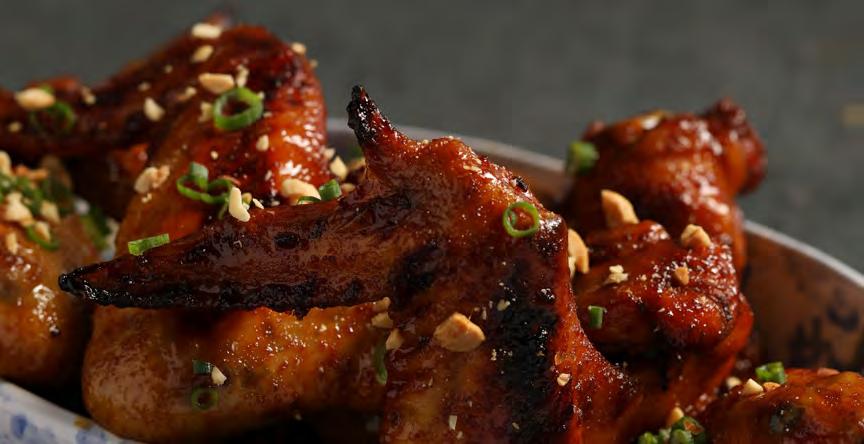
SERVES 6 AS AN APPETIZER
For the wings:
4 pounds whole chicken wings
2 tablespoons canola oil
1 tablespoon smoked paprika
1 tablespoon kosher salt
1 ½ teaspoons granulated sugar
For the glaze:
2 cups bourbon
½ cup sorghum syrup
½ cup brown sugar
¼ cup apple cider vinegar
¼ cup Tabasco
2 tablespoons soy sauce
¼ cup crushed toasted peanuts, for garnish
½ bunch scallions, thinly sliced, for garnish
1. Position a rack in the upper third of the oven. Preheat the oven to 400 degrees.
2. To make the wings, in a large bowl, toss the wings with canola oil, paprika, salt and granulated sugar until evenly coated. Let the wings sit at room temperature while you prepare the glaze.
3. To make the glaze, in a medium saucepan, whisk together the bourbon, sorghum, brown sugar, vinegar, Tabasco and soy sauce. Bring the mixture to a boil over medium-high heat and cook for about 15 minutes, until the liquid has reduced to a thin syrup. Remove from heat and let cool.
4. Meanwhile, arrange the wings on a sheet pan in an even layer. Bake for 20 minutes, then increase the oven temperature to 450 degrees. Flip the wings and bake for 10 minutes more; they should be cooked through at this point. The wing bone should easily pull out of the meat, and the skin should be golden brown.
5. Transfer the wings to a large bowl (reserve the sheet pan; you’re going to use it again). Pour the glaze over the wings and toss to evenly coat, then return them to the sheet pan. Pour any remaining glaze over the wings and bake for 10 minutes more, until sticky and lightly charred.
6. Return the wings and any liquid on the sheet pan to the bowl with the glaze. Toss again to evenly coat the wings with glaze. Arrange the wings on a platter and sprinkle with toasted peanuts and sliced scallions before serving.

Date-Bourbon Butter (makes ½ cup)
Date butter melts seductively on top of warm pancakes, but it’s just as good on cinnamon toast or on a warm croissant in the morning. Use Turkish dates if you can find them.
6 tablespoons (¾ stick) unsalted butter, at room temperature
2 dates, pitted and finely chopped
½ cup bourbon, reduced to 2 tablespoons
1 teaspoon honey
Pinch of kosher salt
In a small bowl, combine the butter, dates, reduced bourbon, honey and salt. Store in an airtight container in the fridge for up to three weeks. Bring to room temperature before serving.
Bourbon Maple Syrup (makes ¾ cup)
Use the best-quality maple syrup you can find for this—it makes all the difference.
¾ cup pure maple syrup
2 tablespoons bourbon
Pinch of kosher salt
In a small bowl, combine the maple syrup, bourbon and salt. Store in an airtight container in the fridge for up to one month.
This recipe was inspired by one I found in a vintage Kentucky cookbook from a time when resources were scarce and bread crumbs were cheaper than flour. We may not need to be so frugal anymore, but I love the texture of bread crumb pancakes. They are hearty with bite and bounce and chew. Top the pancakes with addictive Date-Bourbon Butter.
1½ cups panko bread crumbs
3 cups whole milk
½ cup all-purpose flour
2 tablespoons sugar
1 tablespoon baking powder
1 teaspoon kosher salt
1 large egg, beaten
1 tablespoon unsalted butter, melted Date-Bourbon Butter (recipe at left), for serving Bourbon Maple Syrup (recipe at left), for serving
1. Place the panko in a large bowl. In a small pot, heat the milk over medium heat just until bubbles start to form around the edge of the pan. Pour the hot milk over the panko and whisk to combine, then let soak for 10 minutes.
2. In a separate bowl, combine the flour, sugar, baking powder and salt. Add the flour mixture to the panko mixture, along with the egg and melted butter. Whisk thoroughly to remove any lumps.
3. Heat a large cast-iron skillet over medium heat. For each pancake, pour ¼ cup of the batter into the skillet and cook until the bottom is golden brown and the edges look dry. Then flip and cook on the second side for 30 seconds. Transfer to a plate and repeat with the remaining batter.
4. Serve the pancakes warm, with Date-Bourbon Butter and Bourbon Maple Syrup.

Excerpted from Bourbon Land by Edward Lee (Artisan Books). Copyright © 2024. Photographs by Jessica Ebelhar.
Musical artists partner with high-profile distilleries to introduce new labels to the market
BY JACK BRAMMER
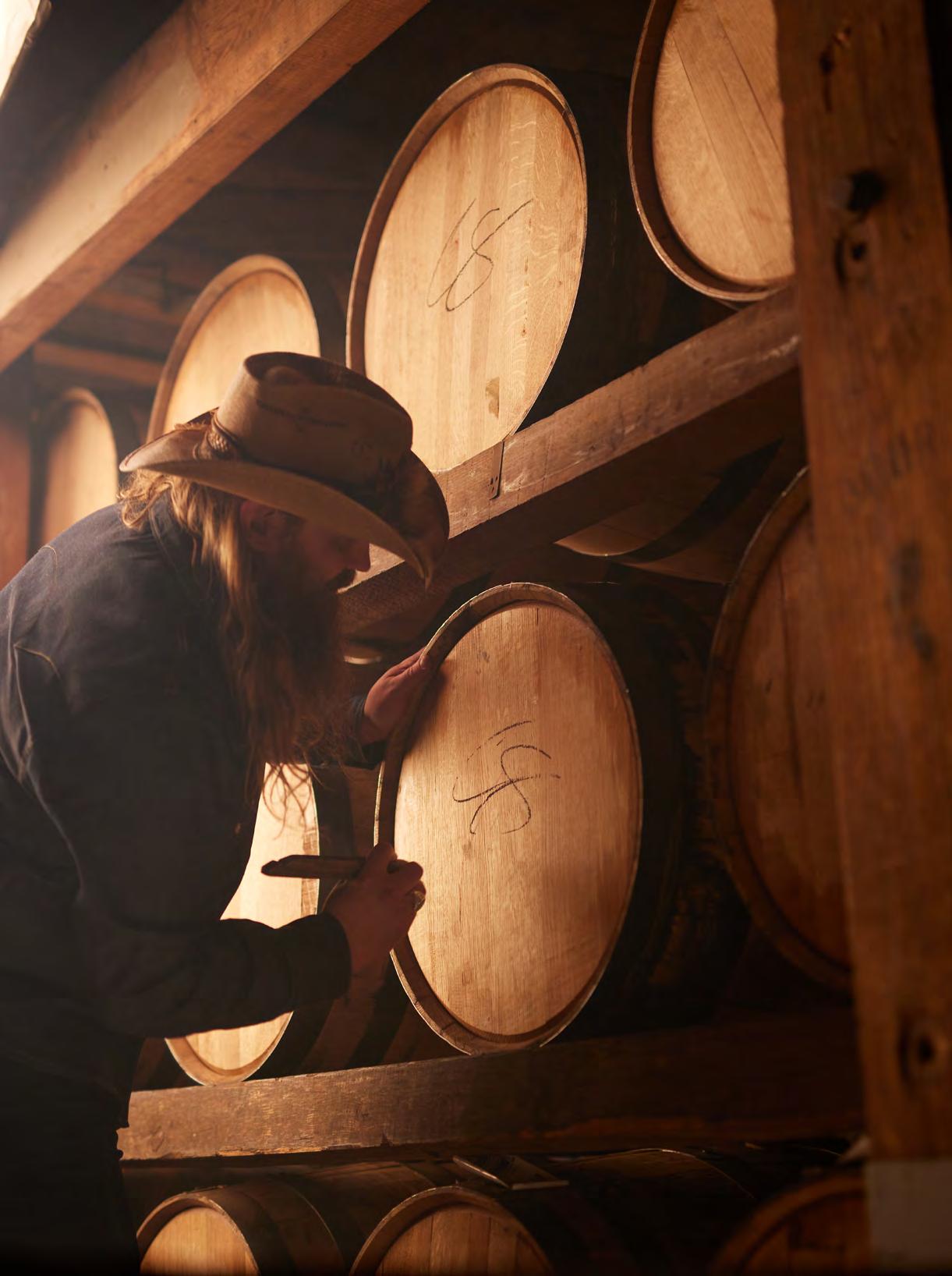
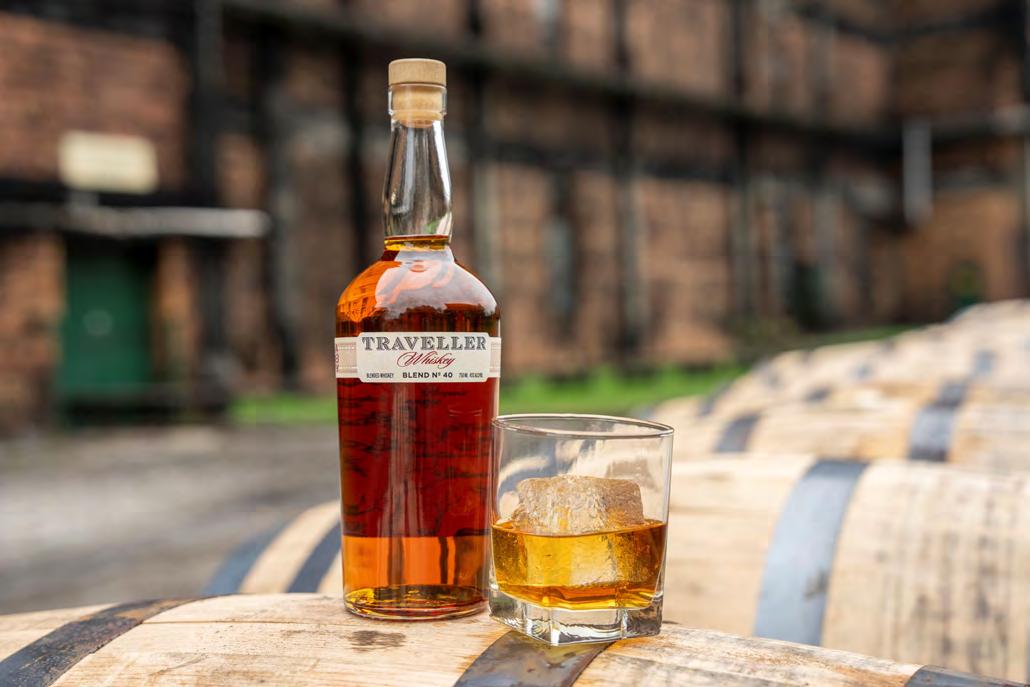
Country music singer/songwriter Chris Stapleton of Johnson County swooshed his palate numerous times with various blends of whiskey, all in the name of work. He was sampling spirits with Buffalo Trace Master Distiller Harlen Wheatley in Frankfort. The two finally arrived at the premium-blended whiskey last March. It is now known as Traveller Whiskey.
The Grammy–winning star said of the collaboration, “Partnering with Buffalo Trace Distillery and Harlen Wheatley feels like a bucket-list scenario for me. Some things just make total sense—and this is definitely one of those things.”
Later this year or early next year, in Henry County near the rural community of DeFoe and an Amish grocery store that makes humongous deli sandwiches, a new distillery named Heaven’s Gate is expected to open. It has the backing of legendary musician Bob Dylan.
On the evening of March 27, in its new distillery at Greyline Station in downtown Lexington, Bespoken Spirits—an innovative California bourbon maker known for its pioneering approach to aging bourbon—held its
grand opening of a new distillery. About 1,800 people attended.
Famed Southern rock group Lynyrd Skynyrd was the star attraction of the event, playing an acoustic set. The band has partnered with Bespoken Spirits to launch its Hell House whiskey label. Band members eagerly signed the bottles of liveliness for consumers.
More and more celebrities—from musicians to sports figures to film and TV actors—are adding their names to liquor brands.
“It’s a big trend in the liquor industry,” said Carla Carlton, who goes by “The Bourbon Babe.” “For many of the escalating number of distilleries, a celebrity added to its name is a great marketing tool.”
Carlton, of Louisville, wrote the book Barrel Strength Bourbon: The Explosive Growth of America’s Whiskey, which was released in 2017. She still keeps a close eye on the industry.
When Carlton got interested in the industry about 15 years ago, she said there were around 18 state-licensed distilleries in Kentucky. The state Alcoholic Beverage Control Board says 114 distinct locations in Kentucky have an active distiller’s license today.
“Adding a celebrity’s name to your brand can cause

more interest in the product. It often is also a win for the celebrity,” Carlton said.
The rise of social media has helped smaller distilleries compete with larger, well-known family operations, said Carlton. “Slap a celebrity’s name on your product, put that on social media, and you are likely to get more attention for your brand,” she said.
The idea of linking a well-known personality to a liquor is not new, said Carlton. For example, she said that Old Forester Straight Bourbon Whisky, manufactured by Brown-Forman in Louisville, was introduced in 1870 as the first bourbon sold exclusively in sealed bottles.
It initially was bottled and marketed by the former pharmaceutical salesman-turned-bourbon merchant George Garvin Brown, the founder of the prominent Brown-Forman Corporation.
The product was reported to have been named after a popular physician, Dr. William Forrester, who endorsed it for medicinal purposes. The product’s name was changed to Forester to avoid direct reference with the doctor’s name. “So, one of our first bourbons was named, in a way, after a celebrity,” Carlton said.
The boom in celebrity spirit brands exploded in 2017,

when Kentucky native George Clooney sold his tequila brand, Casamigos, to alcoholic beverage giant Diageo for $1 billion.
So many liquors today vie for attention today that it’s sometimes difficult to determine which concoction is worth a shot (pun intended).
It’s hard to pinpoint how many celebrities have partnered with alcohol brands, said Ed Escott of Lexington, owner of Bourbon Obsessed LLC, a website featuring bourbon reviews, distillery reviews and other information about bourbon.
“Some of the celebrities just simply put their name on
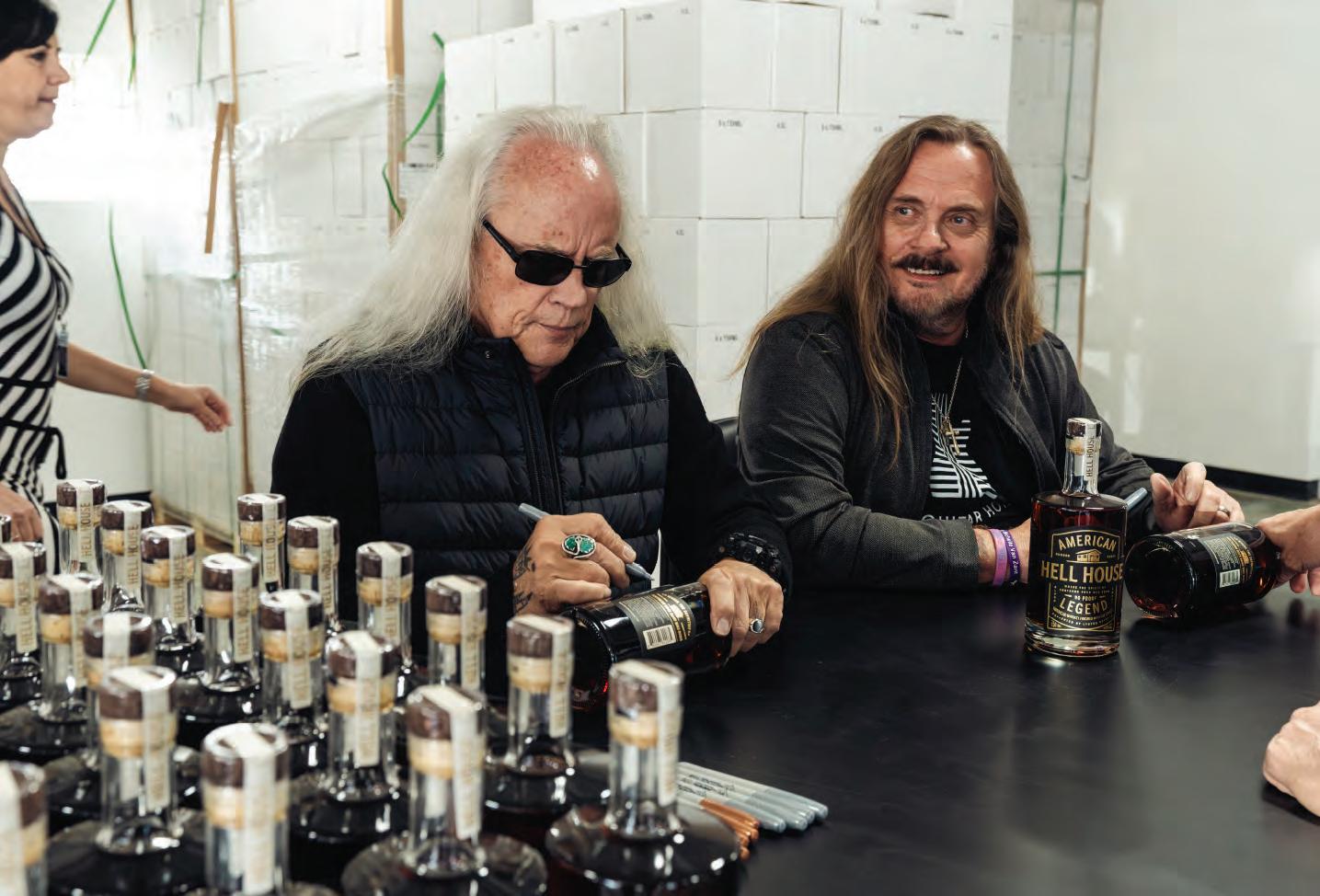
a brand and don’t pay all that much attention to what goes into it or to promoting,” Escott said. “Whereas, others are actually true bourbon [or other spirits] fans and have done a lot of work to help actually pick and blend their products.”
He includes Stapleton, Dylan and Lynyrd Skynyrd in the latter category.
Stapleton and Buffalo Trace like to say that Traveller Whiskey represents a first-of-its-kind collaboration of collective artistry.
Blended and bottled at the world’s most awardwinning distillery under Wheatley’s supervision, Traveller is the result of countless hours of testing, tasting, dedication and craftsmanship by Wheatley and Stapleton.
“Bottles from barrels that Harlen has cared for have been with us for every note we’ve ever recorded, backstage before shows, and in all the moments we’ve celebrated along the way,” Stapleton said. “What we’ve achieved

with Traveller Whiskey not only represents our shared history but also a common artistic vision and uncompromising standards of taste. I couldn’t be prouder of what we’ve made.”
“When making art—and we really do think that both Chris’ music and the whiskey we make at Buffalo Trace are art—you experiment, test, adjust and don’t give up until you’ve got it right,” Wheatley said. “That’s why we experimented with more than 50 blends before agreeing
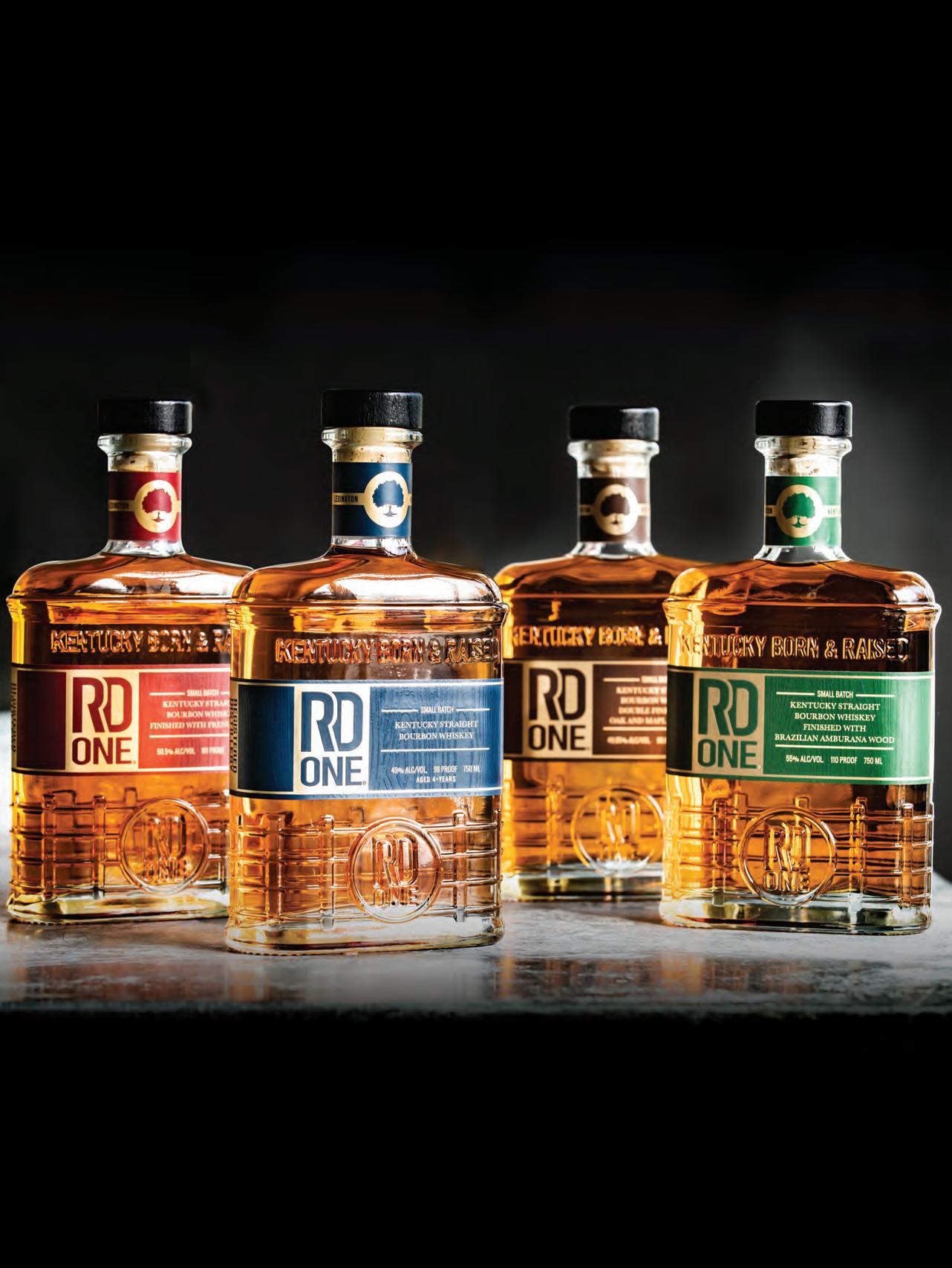

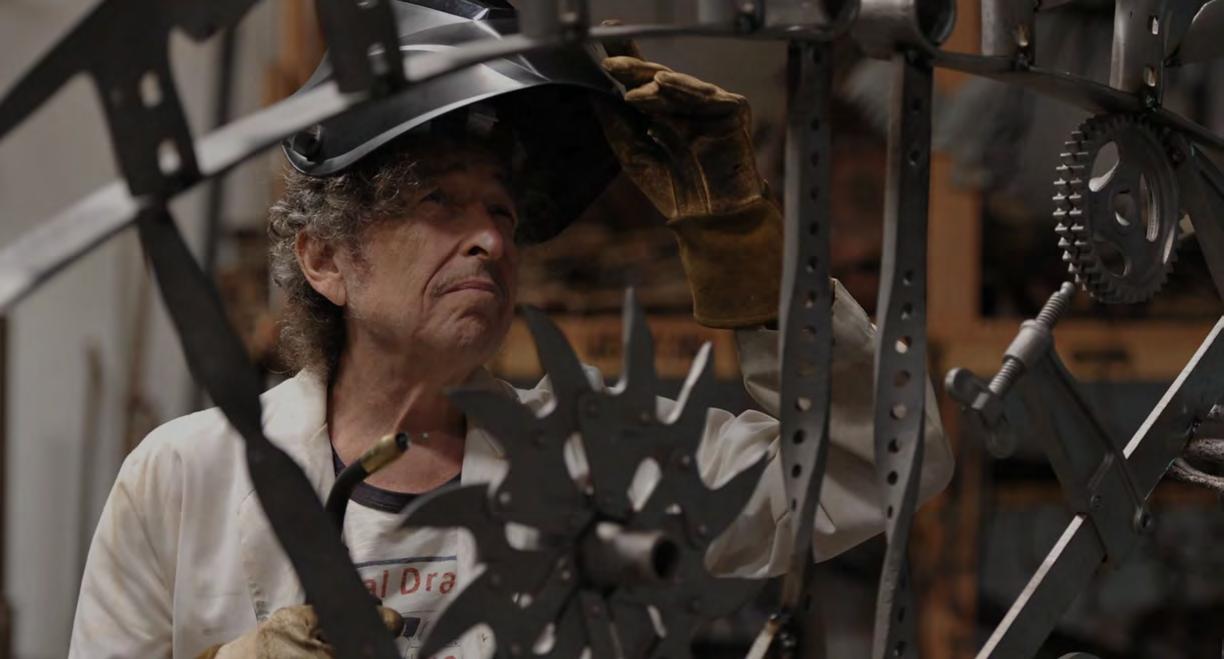
that Blend No. 40 would be it for Traveller.”
Bottled at 90 proof, Traveller Whiskey is characterized by notes of oak, sweet maple, tart currant and leather. Complex aromas of vanilla, aged fruit and buttery shortbread are rounded off by caramel and a touch of oak. The flavor profile also showcases a touch of sweetness, followed by spice, toasted nut and oak flavors, closing with a robust finish.
Traveller is a combination of whiskeys hand-selected from the award-winning distilleries of the Sazerac Company, Buffalo Trace’s parent company.
The title of the whiskey comes from Stapleton’s debut solo album, Traveller, released in May 2015.
Heaven’s Door Spirits, the whiskey brand Dylan founded, is building a new distillery in eastern Henry County on a 160-acre site of rolling hills astride Six Mile Creek. The property once was owned by Squire Boone, Daniel’s brother.
Quietly under development since 2017, the distillery has been producing small batches of liquor on a still since 2018. It also is working on The Last Refuge, a boutique restaurant bar in Louisville that had a soft opening earlier this year, with a grand opening planned for fall.
The businesses, owned by Spirits Investment Partners in Chicago, said the whiskey “embodies the uncompromising passion and restless spirit of Bob Dylan.”
It notes that each bottle label showcases Dylan’s distinctive welded iron gates he created in his studio, Black Buffalo Ironworks.
The distillery’s name comes from the Dylan song “Knockin’ on Heaven’s Door.”
“I wanted to create a collection of American whiskeys that, in their own way, tell a story,” Dylan said. “I’ve been traveling for decades, and I’ve been able to try some of the best whiskey spirits that the world has to offer. This is great whiskey.”
One of the most-often-asked questions about the distillery, said Heaven’s Door quality and distilling manager Alex Lucky, is: “Will Dylan visit?”
“Yes, eventually. Date is unknown,” Lucky said.
Bespoken Spirits, a California bourbon maker known for its pioneering approach to bourbon aging, held the grand opening of its new headquarters in Lexington in late March.
Gov. Andy Beshear praised the move. “Kentucky’s signature bourbon industry continues to see historic momentum,” he said. “This growth is not possible without quality companies like Bespoken Spirits believing in Kentucky and the business-friendly environment we have established.”
Jared Bickel, director of customer relations and marketing for Bespoken Spirits, said it has several

investors, including Major League Baseball Hall of Famer Derek Jeter
The business has partnered with Lynyrd Skynyrd through events and relationships and created a one-of-akind whiskey, Hell House, that encapsulates the band’s essence, Bickel said.
That essence may be found in its signature song, “Free Bird,” written in 1973 by then-lead vocalist Ronnie Van Zant that can play more than 14 minutes. Van Zant, who was killed in a 1977 plane crash in rural Mississippi at age 29, said the song was about “what it means to be free, in that a bird can fly wherever he wants to go.”
Today, Ronnie’s younger brother, Johnny Van Zant, heads Lynyrd Skynyrd as the lead singer and songwriter, along with guitarist Rickey Medlocke. Both were on hand to sign bottles of Hell House at Bespoken Spirits’ grand opening, where Johnny told Lexington’s FOX 56: “Years ago, we used to say, ‘We need our own whiskey!’ because we drank enough of it in our young days.”
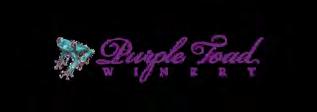
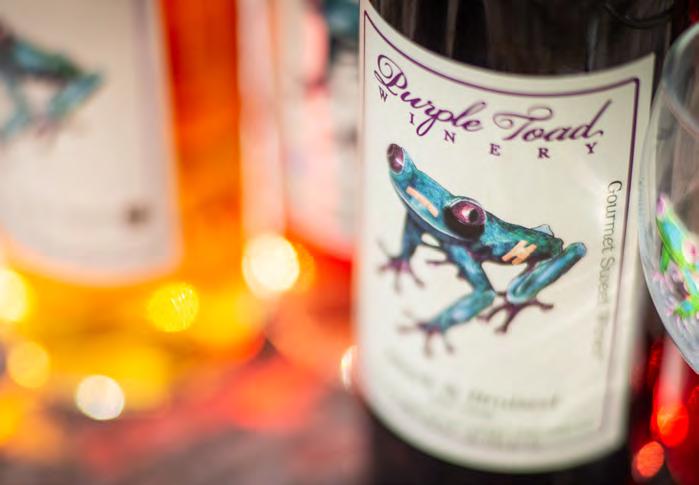




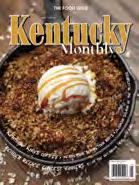



The founders of The Bard Distillery bring bourbon to their Muhlenberg County ancestral home
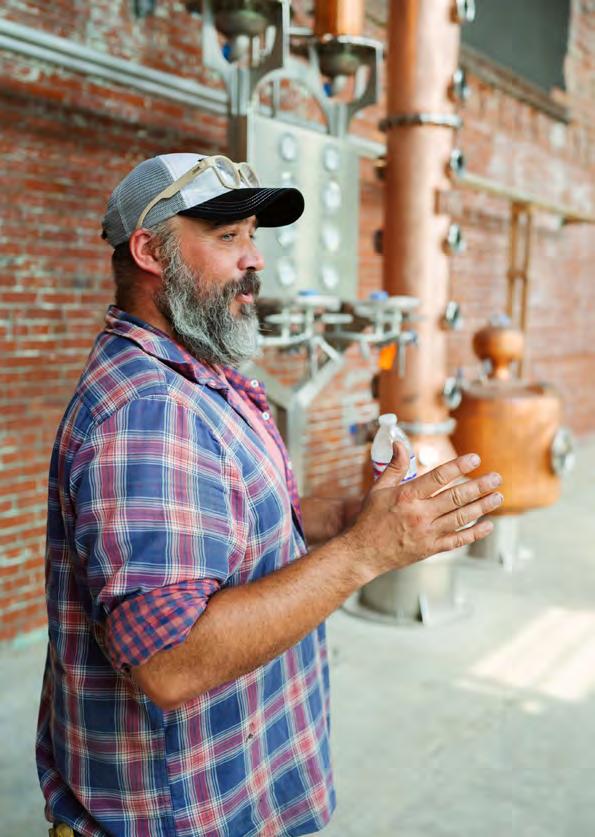
Anearly 100-year-old school building in the former coal-mining community of Graham has been given new life as a bourbon distillery. Founders Thomas and Kim Bard purchased the campus in 2015. Located in Muhlenberg County, The Bard Distillery can be found just off the Western Kentucky Parkway, about an hour from both Owensboro and Bowling Green.
“We did it here because this is our home,” Thomas said. “When this school shut down, this town lost its identity. We’d love to bring some of that back and give this area something to be proud of again, so when people say, ‘Graham, Kentucky,’ people will say, ‘Oh, Bard Distillery is there.’ ”
Thomas’ fourth great-grandfather, William Bard, was the surveyor and co-founder of Bardstown and created the first-ever map of Louisville. William’s brother, David, was the other co-founder of Bardstown. David served in the United States House of Representatives in the Fourth and Fifth Congress in 1803 and 1805. William’s son, Isaac, settled on a farm in Muhlenberg County that now has been in the family for two centuries. Instead of bringing more bourbon to Bardstown, the Bards decided to purchase and renovate the school that four generations of Bards attended, including Thomas himself.
Patience is a virtue in the bourbon industry, and reviving this historic site and transforming it into a craft distillery didn’t happen overnight. After years of cleaning and renovations, The Bard Distillery opened its doors for tastings and tours in December 2019. Although the COVID19 pandemic threw off Thomas and Kim’s timeline, it gave them time to focus on renovations, distribution, building their brand, and diversifying their products.
From award-winning signature Cinder & Smoke bourbon to seasonal orange cream liqueur, all the familyowned distillery’s spirits are bottled and labeled by hand. Cinder & Smoke, the flagship bourbon, is named for its Level 4 barrel char and its smoky finish. Thomas explained that its name also refers to being “reduced to cinders” or brought back to basic elements.
Smoldering cocktails emerge from the cocktail smoking box at the The Bard Distillery’s tasting bar. There, patrons can sample the limited-edition small-batch Cinder & Smoke Founder’s Select, which is not only selected, but also blended, bottled, labeled and signed by the founders. There’s also a 17-year-old bourbon that was sourced and then aged in-house before it was released.
Eventually, all the spirits will be made onsite, but for now, the small-batch Muhlenberg bourbon—the base from which the flavored spirits are made—is all that the
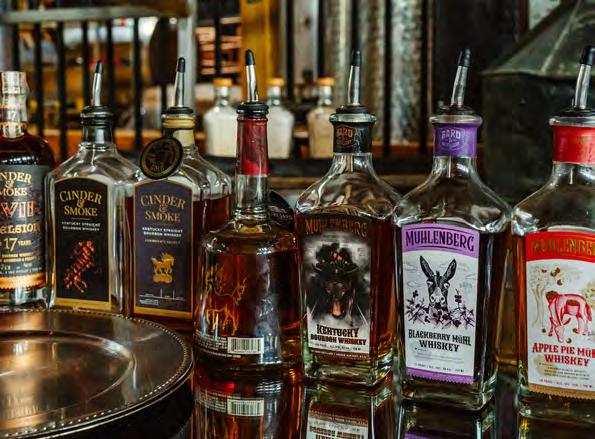
two 60-gallon pot stills on the gymnasium stage can handle. The Bards are preparing for a big ramp-up in production, with a new 14-inch Vendome-brand column still that could take production from three barrels a week to 20 barrels a day.
Thomas and Kim met when she was a race car driver in the NASCAR Busch series. As he was working his way up the racing ranks, Thomas became a mechanic and crew member on Kim’s race team. According to Thomas, Kim was the first female monster truck driver in Australia, where she still races.
“I love teaching people new things, and that’s how I got into NASCAR,” Kim said. The Jacksonville, Florida, native grew up drag racing and taught others how to drag race cars as an instructor. She also served as a school principal outside New Orleans for several years. “Teaching people comes naturally to me,” Kim said. “So when people come in for a tasting or a tour, I get to educate them on what we’re doing here.”
Coordinating a racing team prepared Kim for the teamwork that it takes to run a distillery and create a legacy brand. Dealing with the regulations that come with driving a team car helped her deal with the countless rules and regulations surrounding the production of spirits.
Thomas has a background as an engineer and in quality management, which has helped him manage a project of this scope. His process-oriented, order-of-operations approach has helped when it comes to everything from renovating the school buildings to building the brand.
Thomas and Kim had been kicking around the idea of owning a distillery ever since their first visit to Maker’s
Mark in 2006 while on a trip to see some cousins in Central Kentucky. Neither of them had ever been to a distillery, and they were fortunate to be given the tour by seventh-generation Kentucky whiskey producer and Kentucky Bourbon Hall of Fame legend Bill Samuels After enjoying the tour and meeting the maker of Maker’s, the Bards fell in love with the history and the process of making bourbon.
“Then, as time went on, even though we stayed in racing and had other careers, we kept talking about it, learning more about the industry, meeting people in the industry, joining all the associations, hitting the Bourbon Trail, going on the tours, and we just kept falling in love with it more and more, learning more about it,” Thomas explained. “In about 2015, we were both in careers, both of us ready for a change, so we looked at each other and said, ‘Why don’t we finally do this? We talked about it long enough.’ ”
When it came time to pick a location, the Bards chose a spot just 5 miles from the family farm in Muhlenberg County in order to benefit the community. They knew the school buildings had good bones, and it turns out that the layout of the campus is just as suitable for bourbon as it was for kids. The words “Character Building” over the schoolhouse doorway once referred to young minds but now applies to building flavor profiles.
One of Thomas’ former schoolteachers even helped paint!
“We want people to be proud of the fact that this is here and also to identify with it,” Thomas said.
The Bards plan to continue growing, ramping up production, expanding the brand globally, and becoming a bigger presence in the industry. They are active members of local nonprofits and intend to donate to community causes and hold fundraisers, using the distillery to drive change in the community and provide jobs.
Thomas and Kim plan to offer unique experiences at the distillery, including technical tours with more information about the production process, barrel classes and concerts. They also aim to add murals, a 7-acre lake and a restaurant to make The Bard Distillery, which is a part of the Kentucky Bourbon Trail Craft Tour, a true destination distillery.
“The Bard family has a history of striving to do the best they possibly can,” said Thomas, who comes from a long line of leaders. Another fifth great-uncle, Richard, was part of the Continental Congress in Philadelphia and a voting member of the Constitutional Convention to ratify
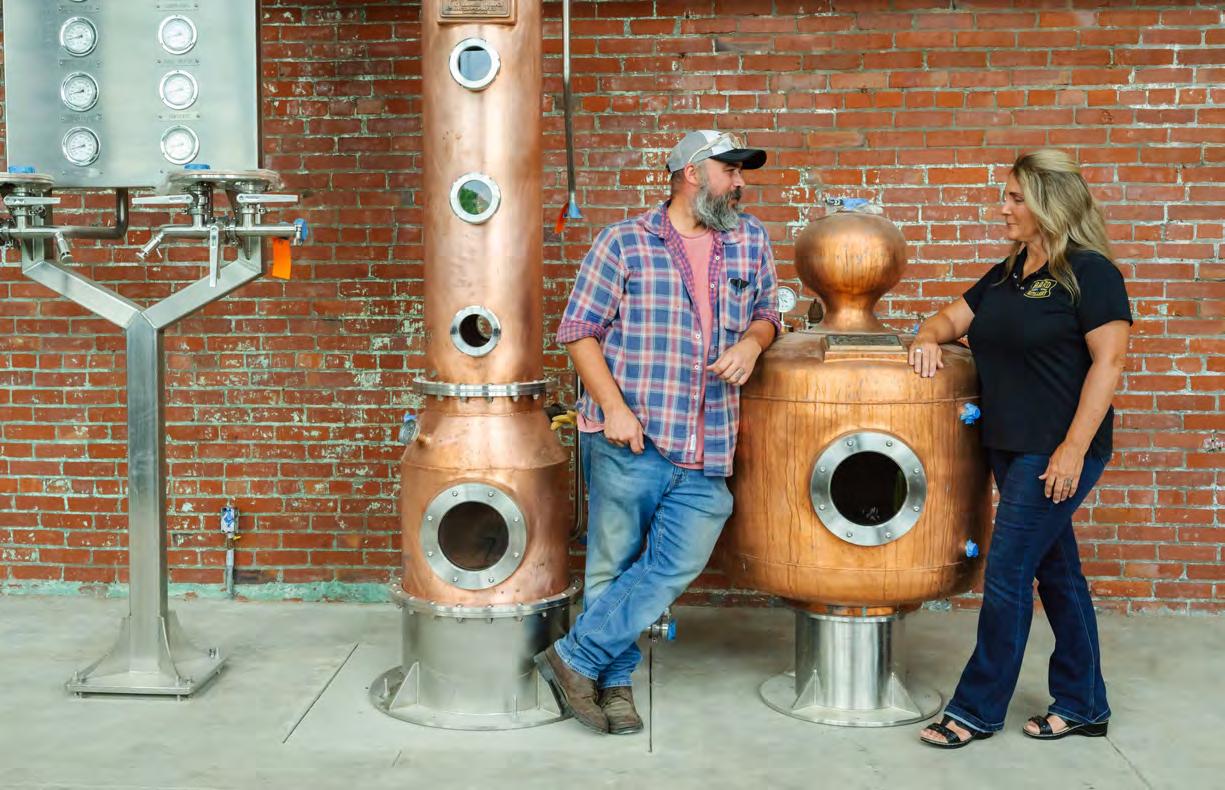
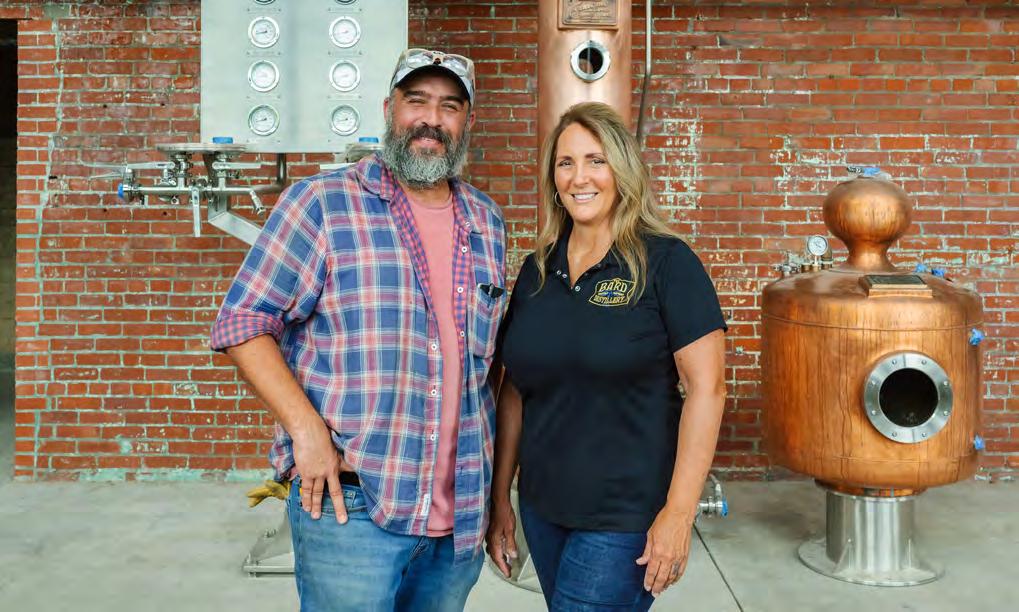
the U.S. Constitution. Richard’s great-grandson, Thomas R. Bard, served as a U.S. senator from 1900 to 1905.
A Presbyterian minister, Isaac earned a reputation in the region as one of the best traveling orators, speaking at revivals from town to town. Issac’s father, William, was the surveyor and adventurer who founded Bardstown with his brother in the 1700s.
“When I think back on that, I think, OK, I come from a family of people who want to lead, who want to do things for the right reasons, do things for the long haul, and not stop until the job is done,” Thomas said. “So, with that
mindset, that’s how I’ve been able—on my end, anyway— to put my blinders on and just truck through this process to get it going, knowing that we’re looking, not just to the next few years, but looking at the next 10-20 years— looking forward to what impact am I making.
“Despite COVID, despite all of the hurdles of trying to start this business, we’re excited because it looks like our timing is pretty good. We’re exhausted, but we’re excited. We’re proud to be part of this industry, especially in Kentucky. It’s just been a lot of fun.” Q

Fruit Basket Cocktail
1 ounce Muhlenberg Apple
Pie Mühl Whiskey
1 ounce Muhlenberg
Blackberry Mühl Whiskey
1 ounce lemon juice
2-3 dashes bitters Sprite
1 dried blood orange slice for garnish
2 blackberries for garnish
Combine first four ingredients in a cocktail shaker with ice or stir with ice in a large glass. Pour into a rocks glass over ice, top with Sprite, and garnish with dried blood orange slice and blackberries.
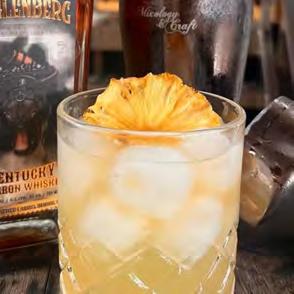
Muhlenberg
Bourbon Punch
1 ounce Muhlenberg
Kentucky Bourbon Whiskey
2 ounces pineapple juice
1 ounce lemon juice
1 ounce simple syrup
Pineapple wedge for garnish
Combine first four ingredients in a cocktail shaker with ice or stir with ice in a large glass. Pour into a rocks glass over ice and garnish with pineapple wedge.
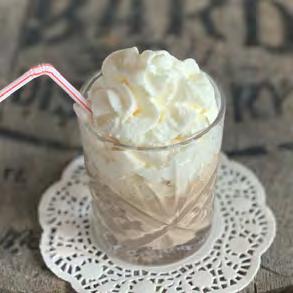
Muhlenberg White Russian
2 ounces Muhlenberg
Salted Caramühl
Cream Liqueur
½ ounce Muhlenberg
Silver Mühl Whiskey*
2 ounces strong coffee
Caramel sauce
Reddi Wip
Combine first three ingredients in a cocktail shaker with ice. Pour into a rocks glass over ice, top with Reddi Wip, and drizzle with caramel sauce.
*Add more Muhlenberg Silver Mühl whiskey for a big kick!


Blackberry Blood
Orange Cocktail
2 ounces Muhlenberg
Blackberry Mühl Whiskey
2 ounces orange juice
2 ounces ginger ale
1 ounce lemon juice
Dried blood orange slices for garnish
2 blackberries for garnish
Combine all ingredients except garnishes in a cocktail shaker with ice or stir with ice in a large glass. Pour into a rocks glass over ice and garnish with dried blood orange slices and blackberries.
IF YOU GO:
Open 10 a.m. to 5 p.m daily, except holidays, for tastings and tours






“Bourbon, Kentucky bourbon especially, is like Dante’s Inferno in a glass, fire walks down your throat, lungs and heart and everything in between with an unpleasant after-taste. We got along just fine.”
Bruce
Crown , Forlorn Passions


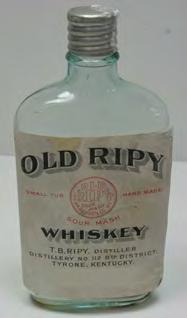
The legacy of Kentucky’s storied distillers extends to their opulent residences
BY SAMUEL PETERS


Kentucky’s bourbon heritage is steeped in history, with its origins tracing back to early settlers who brought their culture and knowledge of distilling from Europe to the fertile lands of the Bluegrass State. In addition to the storied distilleries, that heritage includes the grand mansions that were the residences of some of the industry’s most influential figures.
Located on South Main Street in Lawrenceburg, the T.B. Ripy Home is a striking example of the grandeur associated with Kentucky’s bourbon aristocracy.
Completed in 1888, this mansion was the home of Thomas B. Ripy, a prominent bourbon industry figure and co-founder of Ripy Brothers Distillery.
James Ripy, T.B. Ripy’s father, was an immigrant from Northern Ireland who settled in Lawrenceburg in 1830. He began work as a store clerk while he was in his 20s and went on to become a successful merchant and distributor of household goods, including bourbon, in the mid-1840s and ’50s. He bought several small distilleries in and around Anderson County.
In 1869, James, T.B. and James’ other son, James P. Ripy, built a large distillery on Wild Turkey Hill and named it Ripy Brothers Distillery. Boosted by what became a prosperous distillery, the Wild Turkey Hill area developed into a community that the elder James called Tyrone in honor of his home county in Northern Ireland. At its peak, Tyrone had a population of 1,500, with stores along a square, a city hall and a post office. The Ripy operation was the largest distiller in the world from 1880-1905.
T.B. Ripy built an 11,000-square-foot home, completed in 1888, on Lawerenceburg’s Main Street. Today a cherished landmark and destination, the Ripy Home hosts bourbon-related events each month and can be booked for weddings, showers, reunions and other events. The
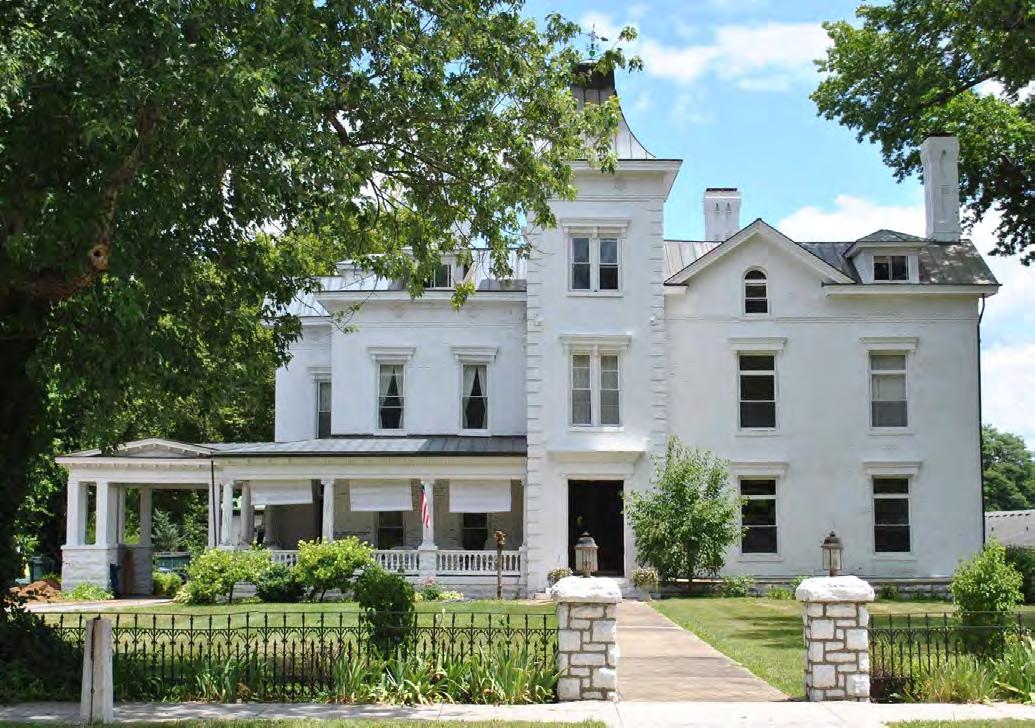
stunning Queen Anne-style mansion, which is listed on the National Register of Historic Places, offers visitors a glimpse into the life of one of Kentucky’s influential bourbon pioneers and his impact on the local community.
Located on Lawrenceburg’s Main Street a couple of houses from the T.B. Ripy Home is the Saffell House, which was constructed in the unique Richardson Romanesque style named for famed Boston architect Henry Hobson Richardson. It was built around 1890 for pre-Prohibition bourbon mogul William Butler Saffell
W.B. Saffell started his career in the industry as a teenager and worked for more than two decades at the McBrayer Distillery, which was owned by distiller and politician W.H. McBrayer
Saffell struck out on his own in 1889, when he built a 350-barrel distillery near Alton, a community northwest of Lawrenceburg. In 1903, Wine and Spirit Bulletin gave this account of the distillery: “Mr. Saffell has a warehouse
capacity of 21,000 barrels … By his carefulness and knowledge of the business, he has built up a high reputation and a successful business.”
Saffell spent his entire life working in the bourbon industry and died in 1910. His distillery continued production until Prohibition.
Saffell House is a beautiful, imposing home set back from South Main Street. It was turned into a funeral home around 1940, and an extension to the house was built in the 1950s to accommodate an expanding funeral home business.
About 20 years later, the funeral home closed, and the structure was divided into apartments. Around 10 years ago, a portion of the Saffell House once again became a funeral home, with apartments remaining on the second floor.
The mansion stands as a symbol of the Saffell family’s success and influence in the region. Today, it is a wellpreserved historical site that offers visitors to the funeral home section insight into the opulent lifestyle of Kentucky’s bourbon elite.

T.B. Ripy Home • 320 South Main Street, Lawrenceburg
502.680.0948 • tbripyhome.com/bourbonhouse Berry Hill Mansion • 700 Louisville Road, Frankfort 502.564.3000 • historicproperties.ky.gov
The Dowling House, located across the street from the Ripy House in Lawrenceburg, was built in 1886 by John Dowling and his wife, Mary, the daughter of Irish immigrants.
Born in County Roscommon, Ireland, the 12-year-old John Dowling and his brother, Edward, immigrated to the United States in 1853 to flee Ireland’s potato famine. As an adult, Dowling operated a distillery in partnership with T.B Ripy in Clover Bottom at Tyrone, 3 miles east of Lawrenceburg. Dowling later sold his interest in the distillery to Ripy and bought the Tyrone-based Waterfill and Frazier Distilling Company in 1903. Dowling died that year, and the distillery was destroyed by fire in 1904.
Following Dowling’s death, the distillery was rebuilt by his widow and their sons. They enjoyed some success, and when Prohibition was imposed, Mary continued the operation illegally. She became notorious in the industry, acquiring the moniker “The Mother of Bourbon.”
Although the Dowling family is no longer involved in the distilling business, whiskey is still produced under the Mary Dowling Whiskey Co. label in Lawrenceburg.
Architecturally, the Dowling House projects the lavish historic elements of the Italianate and Queen Anne styles. The building has been listed on the National Register of Historic Places since 1979. Over the years, the Dowling House has been a funeral home, a dentist’s office and a lodge. Today, the 7,740-square-foot, 2½-story dwelling houses four apartments and is not open to the public.

A Colonial Revival-style building, Berry Hill Mansion sits on a hill overlooking the state Capitol. It was designed by William J. Dodd and built in 1900. The 200-acre area surrounding the home was named Juniper Hill because of the vast number of red cedar trees on the property.
Born in 1856 in Indiana, George Franklin Berry was the son of Hiram Berry, who partnered with renowned distillers W.A. Gaines and E.H. Taylor to form W.A. Gaines and Company distillery in the 1860s. George later became an executive in the Frankfort operation, which produced Old Crow and Old Hermitage bourbons, among other whiskeys. When Hiram died in 1896, his shares of the distillery went to George.
George prospered and purchased 37 acres in Franklin County from a man known as “Preacher Arnold.” On this land, he built Berry Hill Mansion.
In 1927, George retired and sold his shares in the distillery. He died at his estate in 1938. The Commonwealth of Kentucky purchased the property in 1957 for $50,000, and it was used as the State Library until 1982, when the Kentucky Department for Libraries and Archives headquarters was built.
Today, Berry Hill Mansion is used as a venue for weddings, meetings and other events. The first floor is available for guided tours, conferences and receptions, and the second floor houses offices for state government agencies.
The estate’s significance is not limited to its architectural beauty; it also represents a period in Kentucky’s history when bourbon was more than a drink—it was a symbol of wealth and influence. Q

Director Teddy Abrams finds creative ways to share the Louisville Orchestra’s music throughout the city and across the Commonwealth
BY JARRETT VAN METER
For the first eight years of Teddy Abrams’ time in Louisville, an oft-covered element of his wunderkind charm was the fact that he did not have a driver’s license. Most of his duties as director of the Louisville Orchestra were within biking distance of his NuLu neighborhood home, and for those that weren’t, he hitched rides. Fans smitten with the image of the hardpedaling maestro may perhaps be momentarily disheartened to learn that the 37-year-old Abrams now has both a license and a car.
Yet the development has been a win for what already was a deep and dynamic relationship between Abrams and his adopted home. Owning a car—which is electric— has enabled him to explore new places and draw even more inspiration from the state that has already served as the creative fuel for many of his projects and initiatives.
“I will say that, as a Kentuckian, my life has changed, generally for the better,” he said of getting his license and a car. “It’s funny how getting a license in Kentucky made me see how small my own local world was. What I could actually see and experience about Louisville, Kentucky, was so limited by the places I could get to, and that has just exploded. I feel like I’m getting to know the whole world in a new way … I feel like a 16-year-old, basically.”
Abrams moved to town in August 2014 from Detroit, where he had been the assistant conductor of the Detroit Symphony Orchestra. This was pre-driver’s license, so he
asked a Michigan friend to drive him down to his new life in Kentucky and keep him company during the first few days of the moving process. On their second day in town, Abrams and the friend went out for lunch at Gralehaus on Baxter Avenue. They sat outside in the soft sun, ate grits, and watched the people whom Abrams would aim to serve through his music.
“I remember thinking, ‘You know what? This is all going to work out … This is going to be OK,’ ” he said. “I know that’s a ridiculous thing, but it was such a great lunch—it was the right setting; it was a beautiful day; and I was just thinking to myself, ‘Yeah, I made a good choice.’ ”
A decade later, he agrees with his younger self. Most major directors do not live in the city of the orchestras they head, and Louisville does not have the same glossy sheen as New York or Los Angeles, yet Abrams opted to build his life there. In doing so, he has come to understand and authentically appreciate the stories and traditions that he now weaves into his work.
“One of the things I just love about this place is that there’s something here that keeps generating whatever it is—stories, music, raw materials—that people need and want and crave,” he said. “There’s something both romantic and sometimes heartbreaking about that. Even though I wasn’t born here, I identify now as a Kentuckian. I want to be a part of that story and wherever that’s going to go next, because I think it’s our time to represent that story, to take hold of it and not let others steer it.”
•


Abrams seems to operate at three levels: national, statewide and hyper-local. He moves seamlessly among the three, always with the same amount of attention and care. Beyond state lines, he is working to get his Muhammad Ali-inspired musical ready for its 2025 Broadway premiere. He occasionally guest directs for other cities’ orchestras and was profiled by The New York Times in August 2023. Last February, he won the Grammy Award for Best Classical Instrumental Solo for The American Project. He brings big names to Kentucky to collaborate, such as legendary cellist Yo-Yo Ma, who joined the orchestra for a special performance inside Mammoth Cave.
“[Abrams] created a very unique experience that was all about Kentucky, Kentucky’s history and where Kentucky is now in some ways,” Louisville Orchestra concertmaster Gabriel Lefkowitz said of the Mammoth Cave experience. “That’s what it’s all about—telling important stories and bringing people together—and it absolutely defied every expectation of what an orchestra concert and what music can be.”
On the statewide level, “In Harmony—the Commonwealth Tour” has proven to be a means of getting to know different communities beyond Jefferson County. To date, “In Harmony” has put on 127 events in 38 counties. Beginning in November 2022, the landmark tour has reached more than 27,000 Kentuckians and featured guest musicians Michael Cleveland and his band Flamekeeper, mandolinist and singer/songwriter Chris Thile, and Richmond native and violinist Tessa Lark. The tour is slated continue into 2026.
Whenever possible during the tour, Abrams and the orchestra arrive in town early to forge an authentic relationship with a community so that, when it is time to take the stage, there is a clear and open channel for connection. The 2023 trip to Harlan was particularly influential. Abrams was struck by the small town’s deep history, landscape and hospitality. He spent several days eating at local restaurants and talking with local residents, listening and learning. On the night of the performance, the town closed down, and the high school auditorium was packed. A party was thrown in appreciation of the orchestra, and Abrams was gifted with a jar of real moonshine.
“It was everything I kind of dream this program would be,” he said of the trip to Harlan.
Abrams also takes on lesser-seen, lesser-known musical initiatives. He and Thile wrote music together that they performed at the Mayfield Youth Detention Center in Western Kentucky. At home in Louisville, he developed a project called “Once Upon an Orchestra,” for which he takes orchestra ensembles to play in the Louisville Free Public Library branches. The free concerts aim to provide “storytelling through music.” They feature original compositions and take place at every branch in the LFPL system.
“That means that the orchestra is showing up in every single neighborhood in town,” Abrams said. “This is obviously designed for families—multi-generational families. We want grandparents and parents and kids all coming together to these events, and that’s exactly what’s happening.”
Lefkowitz, who has served as concertmaster for the Louisville Orchestra since 2016, said Abrams is passionate
















Juniors and seniors in high school from across Kentucky come to Gatton to take courses at Western Kentucky University, conduct research, and study abroad. They thrive in Gatton’s supportive environment designed just for them. With scholarships covering tuition, housing, and meals, Gatton students explore their infinite possibilities.
Explore your infinite possibilities. Applications for the Class of 2027 will open August 1, 2024. Learn more at www.wku.edu/academy.
WEBSITE: wku.edu/academy EMAIL: academy@wku.edu PHONE: 270-745-6565 facebook.com/gattonacademy @gattonacademy





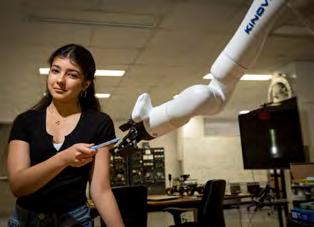





With LEX Studios, Misdee Wrigley Miller has a vision to put Kentucky on the film production map i
BY ABBY LAUB
LEX Studios owner
Misdee Wrigley Miller; opposite page, Wrigley Miller with Wrigley Media Group CEO Joe Livecchi.

Sitting on a barstool in the modern kitchenette space of her newly opened LEX Studios, owner Misdee Wrigley Miller reflected on her reasons to dive further into the entertainment industry with the first-of-its-kind space in Kentucky. Located off Woodhill Drive in Lexington, LEX Studios already is earning significant attention from Hollywood types.
“It’s truer today than ever before that entertainment transports you
somewhere,” Wrigley Miller said. “There’s so much negativity in the world, and entertainment still is the one medium that will allow us to be transported to someplace that doesn’t worry us. And I think that’s healthy and very necessary. If I can be a part of helping create that, of giving people a few hours of just being taken someplace else, then that makes me happy.”
Perhaps there is no better person to help create this type of entertainment, right here in Kentucky—a state not typically
known as a film and television hub. Wrigley Miller is a media veteran, internationally acclaimed horsewoman and owner of Lexington-based Wrigley Media Group, who is familiar with creating things. She is the greatgranddaughter of William Wrigley Jr., who introduced Juicy Fruit and Wrigley’s Spearmint chewing gum in the late 19th century and became majority owner of the Chicago Cubs in 1921. In 1927, the Cubs’ home ballpark was renamed Wrigley Field in his honor. Standing on the legacy

of an innovator and risk taker created a certain fortitude and drive in Wrigley Miller, who first came to Kentucky because of her love of horses. About 20 years later, LEX Studios was born.
• • •
LEX Studios is a 50,000-squarefoot state-of-the-art production facility positioned to shine a light on the Bluegrass State, its creators and its possibilities, while boosting the economy and creating jobs. Located in the building that formerly housed Woodhill Cinemas, LEX Studios is equipped to become a national hub for creative innovation and media entertainment and is the largest facility of its kind in the state. It boasts three soundstages, wellequipped green rooms, numerous office spaces, dining areas for more than 150 people, ample parking and production support, plus optimal Central Kentucky characteristics such as easy proximity to interstates, airports and beautiful Kentucky scenery, a low cost of doing business, and a workforce. The previously

abandoned building took four years to convert to LEX Studios.
The building easily rivals professional studios in Los Angeles, New York, Atlanta and Chicago, with multiple spaces that can serve as different sets. In addition to being a large, one-stop production shop, LEX Studios is a resource for local companies for corporate videos, live streaming or corporate parties and receptions.
LEX Studios feeds a passion for Wrigley Miller, but she’s proud that it also feeds the Kentucky economy.
In 2021, the Kentucky Cabinet for Economic Development established the Kentucky Entertainment Incentive (KEI) to encourage the film and entertainment industry to choose locations in the Commonwealth for filming and production of motion picture and entertainment productions. It increases opportunities for Kentucky citizens to work in the entertainment industry and helps develop a production and post-production infrastructure in the state for film and touring Broadway show
production facilities containing state-of-the-art technologies.
Wrigley Miller said the support has been overwhelming and bipartisan, noting that Kentucky Senate President Robert Stivers and Kentucky Speaker of the House David Osborne have been “two of our biggest flag carriers” for the incentive. “It’s exciting when we can see tangible results in the legislation we pass in Frankfort,” said Stivers. “When we make Kentucky attractive to this dynamic and creative industry, the economic benefits are far reaching in both urban and rural areas. It means more local job opportunities, increased revenue for hotels and restaurants, and so many other services that support the entertainment industry. It’s a substantial economic win all the way around.”
A key case study for reinstating the film incentive was Wrigley Miller’s hit show Relative Justice that created a $2.5 million economic impact for Kentucky in just one season.
Kentucky is gaining attention from creators and producers who are

utilizing the state’s competitive, 30to 35-percent refundable tax credit for up to $10 million.
“Thanks to the Kentucky tax incentive, which is the most robust in the country, we are poised to bring much more film and television production to the state,” said Wrigley Miller, adding that former Kentucky First Lady Jane Beshear championed the incentive during Gov. Steve Beshear’s time in office. “Enhanced production means business for caterers and restaurants, hotels, car rental companies, and new opportunities for talent throughout the state, as well as for those who are interested in a career in production.”
The films are already coming, and the new jobs will require some new training. LEX Studios is partnering with the Kentucky Community and Technical College System (KCTCS)
to create expedited credentialing programs to ensure there are trained workers to fill the many production roles required to create films and television shows, such as set design, hair and makeup, and logistics.
Wilmore’s Asbury University offers a variety of bachelor- and master-level degrees in media communication, screenwriting and film. Earlier this year, Asbury became the nation’s only ARRI Certified Film School. Approximately 80 percent of top-grossing films are shot on ARRI cameras, and close to 65 percent of all award-winning films at the Academy Awards, Cannes Film Festival and Sundance Film Festival are shot on ARRI cameras.
For Jim Owens, Asbury’s dean of the School of Communication Arts, operations like LEX Studios mean more opportunities for his graduates here in the state. “We are excited about the growth of media
opportunities in Kentucky,” he said. “For decades, our film students have had to leave the state if they wanted regular film jobs. Asbury students’ education has been greatly enhanced as more and more film projects land in Kentucky. They not only provide job opportunities for current students and alumni, but these film professionals are mentoring our students to help them move up through the industry.”
Film is the largest program in Asbury’s School of Communication Arts, and Owens said he’s excited to contribute to building a solid personnel base in Kentucky. Asbury students regularly work on summer productions that are either created internally or by Hollywood producers.
To help pull together these efforts, projects by Soozie Eastman of Louisville’s 502 Films, and others happening independently throughout Kentucky, Wrigley Miller said the
next step for Kentucky is to establish a statewide film office.
“We are really good at horses and bourbon and can be good at film,” she said, calling the Commonwealth a “sleeping giant” of film. “When the credit rolls at the end, those [names] represent jobs, and jobs that can and should be held by Kentuckians.”
Tim Sabo, the LEX Studios manager and producer, added that statewide advocacy and organization are key because “we’re trying to make the 70 miles between here and Louisville really small, because we have the space here. If the productions come, they will stay.”
With 25 years of experience, including field production for The Biggest Loser, Sabo moved to Kentucky from California to manage LEX Studios and has plans to turn it into





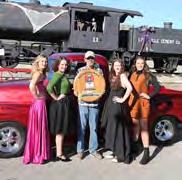
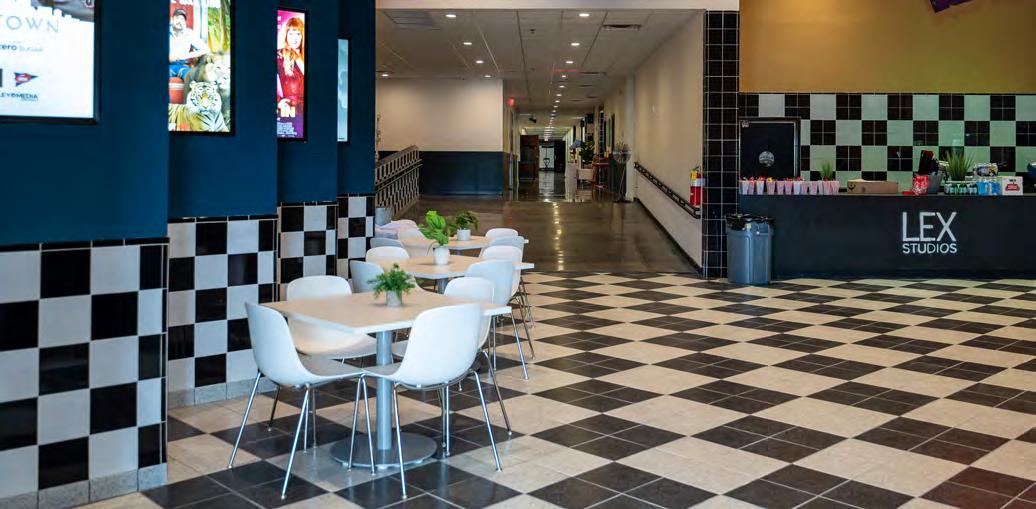
These productions are the future, Sabo pointed out, because of disruptions in the film industry, the changing landscape of streaming, and artificial intelligence that will put the focus more on higher volume shows designed for streaming. “The big $150 million blockbusters are always going to be around, and that’s a whole different animal. But since there are so many streaming services now on every TV, they all have their own channels, and they all need programing,” he said.
Wrigley Miller confessed the upheaval caused her some moments of second guessing. “Just before COVID hit is when I decided to take the plunge and go ahead and build out this theater,” she said. “So, between COVID hitting, the strikes in Hollywood, AI, the massive consolidations, and now the budget cutting, I was wondering, ‘Oh my God, what have I done?’ I have literally gotten into the industry at one of the most difficult times. And thank goodness I have people like Tim, like [Wrigley Media’s CEO] Joe Livecchi, who said, ‘OK, we just got handed a
big basket of lemons, and we’re going to make lemonade out of this.’
“The really great thing about being a very small, privately owned, one-woman company is that we’re able to pivot and make decisions and change our business model quickly. I think that’s going to be the strength of Kentucky and being in Kentucky, and because budget-conscious productions are going to come here. Everything is less expensive.”
• •
•
They are coming, and Sabo has seen that people who had moved to the West Coast to fulfill their Hollywood dreams now want to come home. “What also comes into play is you really have to start targeting people who are from this region,” he said. “People are leaving LA and going back to where they’re from. They want to go home. There is a mass exodus happening. I get emails almost every day from really solid LA people, and they’re like, ‘Thank you for this space; it’s given me a reason to come back to
Kentucky.’ You’d be surprised by the people who are reaching out saying they have connections here and want to raise their families here.”
Plus, he added, “Once you’re in here, you’re sold. You don’t walk out of this space and leave saying, ‘Eh. it’s OK.’ ”
Production business is picking up, and LEX Studios is open for events such as field trips, table reads and pitch sessions for local creators to learn, network and be inspired.
“My goal for next year is to have 14 people sitting around this table figuring out what we’re doing next,” Sabo said.
For Wrigley Miller, LEX Studios is her “next.”
“My legacy is being on the ground floor of building a new industry in Kentucky that will help Kentucky and Kentuckians thrive,” she said.
Though she hails from Chicago by way of Arizona, which she called “a tough place to have a horse farm,” she said, “The world works in such mysterious ways. I was destined to be here in Kentucky.” Q
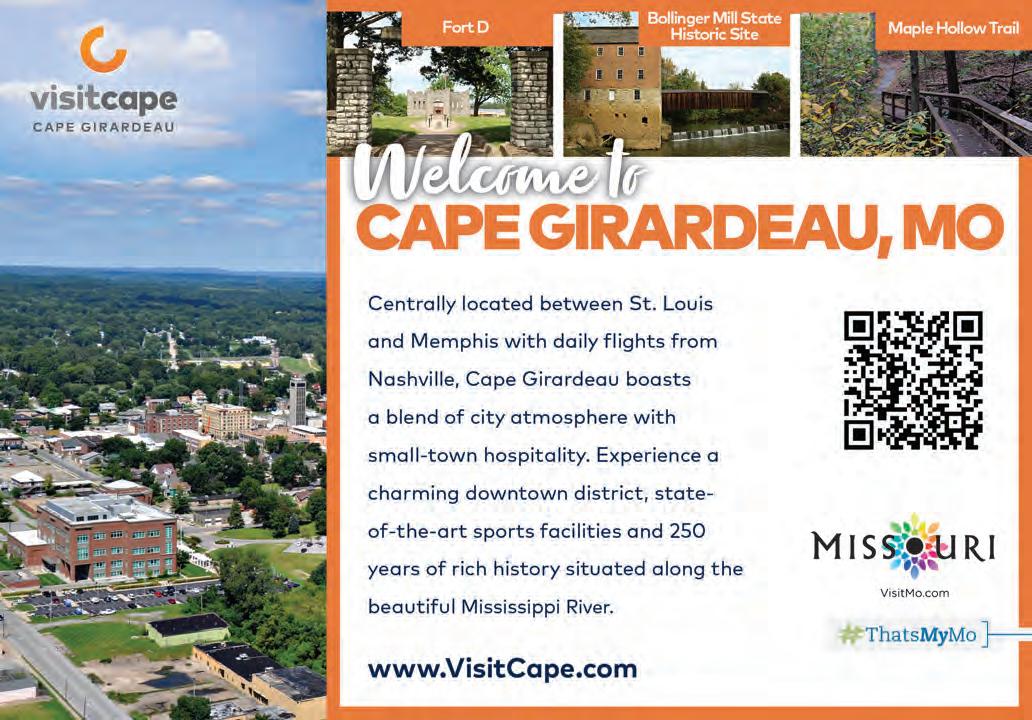





BY JACKIE HOLLENKAMP BENTLEY

Kentucky’s 2024-2025 performing arts season includes a packed roster of music, dramas, dancing, laughing and family fun! Here’s a partial list of the entertainment in store for young and old alike.
9/26 ARTrageous
The Mountain Arts Center, Prestonsburg 606.886.2623 • macarts.com
The MAC’s website says that more than 92 percent of fans have voted ARTrageous the best show they’ve ever seen. See it in person, and experience a fusion of live art, rocking out, laughing, singing and more as members of the audience hold their breath to see if the artist will complete a painting in the allotted time.
10/26 I Put a Spell on You: A Creepy Cabaret
The Carnegie, Covington
859.957.1940 • thecarnegie.com
Get into the Halloween spirit with Queen City Cabaret’s night of musical tricks and treats featuring jazz standards, cult classics and “the best Halloween party in town.” Act fast, as this is a one-night-only show.
10/26 Sugar Skull! A Dia de Muertos
Musical Adventure
Brown Theater, Louisville
502.584.7777 • kentuckyperformingarts.org
For a family-centered evening, head to Louisville for this bilingual and bicultural touring musical that tells the story of a young girl and a charismatic skeleton as they learn the meaning of Dia de Muertos.
11/2 Craig Ferguson: Pants on Fire
Bomhard Theater, Louisville
502.584.7777 • kentuckyperformingarts.org
The Peabody- and Emmy Award-winning former Late Late Show host has worn many hats, from writer to comedian to director and producer. He brings all that to the stage, with VIP meet-and-greet packages available.
+ 11/7
SKyPAC, Bowling Green
270.904.1880 • theskypac.com
On Nov. 2, Journey fans will be treated to a night of “Don’t Stop Believin’,” “Separate Ways,” and many other classics performed by rock tribute band Jeans ’n Classics in collaboration with Orchestra Kentucky.
On Nov. 7, AC/DC fans can rock out with Thunderstruck: America’s AC/DC Tribute. All the classics from both the Bon Scott and Brian Johnson eras will have fans jamming in their seats or up on their feet.
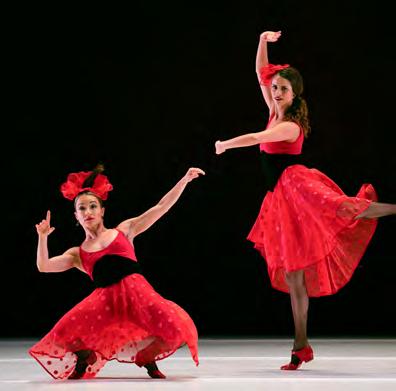

12/8 Avatar: The Last Airbender in Concert
EKU Center for the Arts, Richmond
859.622.7469 • ekucenter.com
Experience the tale of Aang, Katara, Sokka, Toph and Zuko like never before as viewers are treated to a live orchestra performance and fan-favorite scenes play out on the big screen.
12/10 Cirque Dreams Holidaze
SKyPAC, Bowling Green
270.904.1880 • theskypac.com
Experience dancing sugar plums and other holiday visuals in a whole new way with this cirque theatrical event.
1/18 Ronny Chieng: The Love to Hate It Tour
Lexington Opera House, Lexington
859.233.3535 • lexingtonoperahouse.com
You may have seen Ronny Chieng on The Daily Show or the Marvel film Shang-Chi and the Legend of the Ten Rings . You can see him live on stage as he brings his stand-up comedy routine to Lexington.
2/6-16 A Raisin in the Sun
Woodford Theatre, Versailles 859.873.0648 • woodfordtheatre.com
This classic tale exploring the hopes and dreams of the Younger family of Chicago’s South Side returns to the Woodford Theatre’s stage.
2/14-16 Blithe Spirit
Glema Mahr Center for the Arts, Madisonville glemacenter.org
The comedic Noel Coward play follows cantankerous author Charles Condomine as he learns what can happen when a seance goes horribly wrong.
3/11 Paul Taylor Dance Company
Norton Center for the Arts, Danville 877.HIT.SHOW • nortoncenter.com
Delighting audiences since 1954, this innovative New York City-based dance troupe brings its modern moves to Central Kentucky.
4/29 Clue: A New Comedy
The Carson Center, Paducah 270.450.4444 • thecarsoncenter.org
Murder and laughter seem like an odd combination, but it works in this comedy inspired by the beloved boardgame. Clue’s characters come to life this riotous mystery.
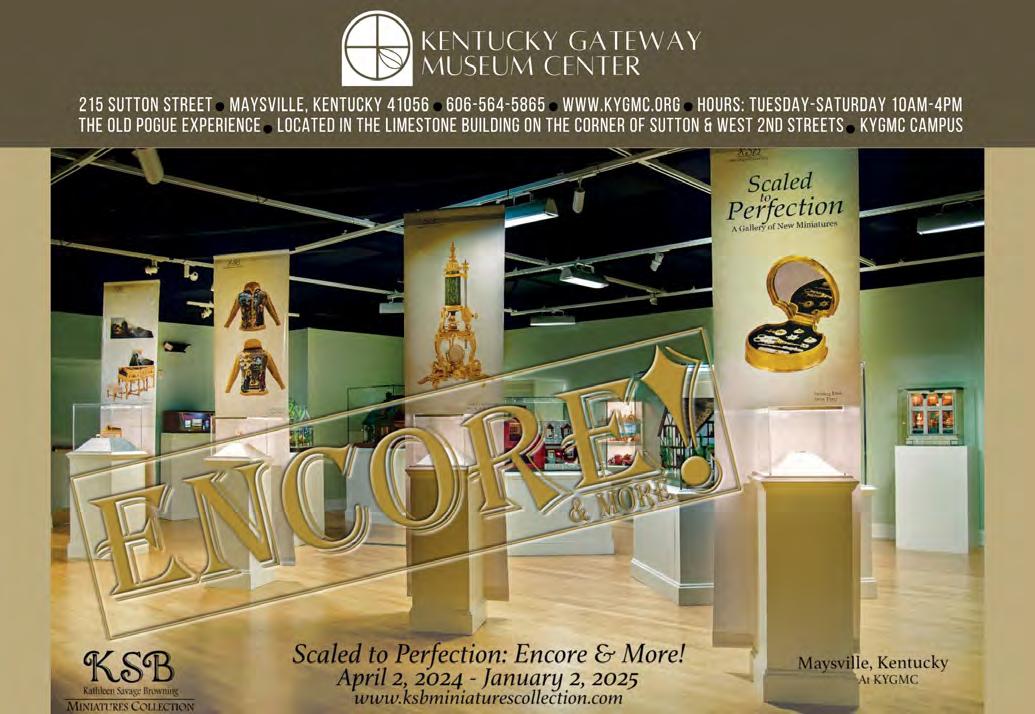
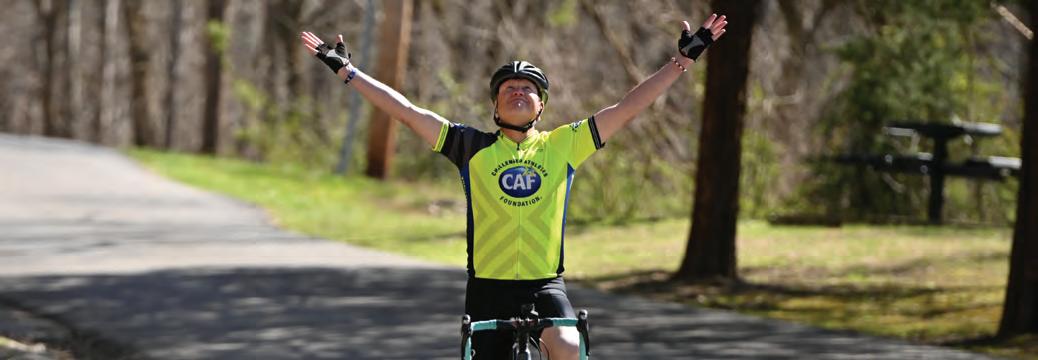
I’m




– Robert Staggs
The 1901 Kentucky Derby was the 27th running of the Kentucky Derby. The race took place on April 29, 1901.
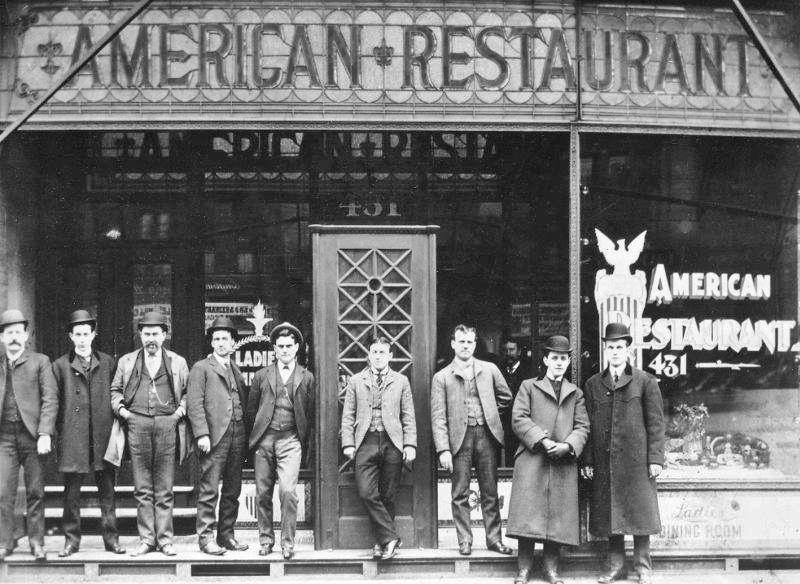
An 1895
In September of 1895, Louisville hosted the annual Encampment of the Grand Army of the Republic (G.A.R.), which brought together Civil War veterans of the Union Army and remains the largest convention ever held in the city. The encampment became a symbol of national unity, as it was the first time Union veterans met south of the Ohio River. The event attracted more than 150,000 visitors and included parades, fireworks and various activities throughout the week. University of Louisville Photographic Archives
FOUNDED 1986, VOLUME 37, NO. 7 a magazine published for Kentuckians everywhere
Charles Hayes Jr. • Founder
Stephen M. Vest • Publisher
Deborah Kohl Kremer • Editor
Rebecca Redding • Typographist
One-Year Subscription to Kentucky Monthly: $25
In response to “Blackberries” in the June/July 2024 edition of Kentucky Explorer, page 48:
I am 90 years old, but even though I’ve lived in Kentucky for only 65 years, I am not considered a native. Every time I talk to one, I’m asked, “Where ya from?” I call myself a “Pentuckian,” having grown up (25 years) in Sykesville, Pennsylvania, and I am familiar with blackberry picking.
I wrote a memoir of my childhood and included a section on blackberry picking. I know precisely what Carol Ingle is talking about. The following is verbatim from my memoir:

“It is almost impossible to describe the profusion of wild blackberries that grew in the fields, hills and woods surrounding Sykesville. They were virtually everywhere and were there for the taking by the townspeople.
“In early fall, when the berries ripened, the pickers would be out there. It was fun to pick at those times because the temperatures were cool and wet with morning dew. There were no bugs at that time. We hadn’t heard about chiggers or ticks, which plagued pickers in Kentucky and the Southern states, as I was to learn about in the future.
“The two best pickers in town, I believe, were my buddy, Donnie, and myself. It was like a competition. We were out at 7 a.m., each carrying a 12-gallon water bucket, and would have them both full at 10 a.m.
“The berries were unbelievable—plump, juicy and very sweet. Some of them measured 1½ to 2 inches long. Our moms could not use that many at once, so after making several pies, they would can the rest of the berries whole.

Kentucky Explorer appears inside each issue of Kentucky Monthly magazine. Subscriptions can be purchased online at shopkentuckymonthly.com or by calling 1.888.329.0053.
Our basement shelves were filled with canned blackberries, which lasted throughout the entire winter. What a treat! Awhile after our mom passed, my brother and I discovered, while cleaning her home, some shelves hidden under the stairs to the basement. On them were 26 quart jars of those beautiful canned blackberries, which had been there for years. Another lost treasure!”
George DeChurch, Louisville
Happy 100th Birthday to Margie Kinslow of Glasgow!
Margie has been a faithful Kentucky Monthly reader for many years. She writes us to share history, news and recipes. We treasure her friendship.
Here is one of Margie’s recipes:
4 ounces cream cheese, at room temperature
2 tablespoons mayonnaise
¼ cup white sugar
2 cups Cool Whip
2 cups seedless red grapes

Half a 15-ounce can pineapple tidbits, drained
1-2 cups small marshmallows
½ cup chopped pecans
1. Combine cream cheese, mayonnaise, sugar and Cool Whip with a mixer.
2. Stir in grapes, pineapple tidbits and marshmallows.
3. Make the night before and keep in freezer.
4. Add chopped pecans right before serving.
By John W. McCauley, Lexington
In the words of Ralph Waldo Emerson: “Do not go where the path may lead, go instead where there is no path and leave a trail.” No words could have better described the gentleman from Kentucky’s 7th congressional district. This “New Deal” Democrat never wavered on his support for education, and during his 33 years in Congress, he cleared the way and carved out many new trails.
Carl Dewey Perkins was born on Oct. 15, 1912, in Hindman to James and Dora Calhoun Perkins. After graduating from Hindman High School, he attended Caney Junior College, now Alice Lloyd College. He taught school in Knott County before attending and graduating in 1935 from the Jefferson School of Law, which later merged with the University of Louisville.

father, Joe McCauley, executive director of the Big Sandy Area Development District, in the Magoffin County Courthouse en route to a meeting with county JudgeExecutive Paul Salyer. As we walked past a group of men, a long arm reached out and grabbed my father on the shoulder, and someone said, “Hey, Joe, where are you headed in such a hurry?” It was Perkins. He had blended in with the gentlemen telling stories and trading knives.
After passing the Kentucky bar exam, Perkins held several public offices, including Commonwealth attorney, state representative and Knott County attorney. He married Verna Johnson in 1938, and they had one son, Carl Chris Perkins. The elder Carl Perkins enlisted and served in the United States Army in Europe during World War II.
In 1948, Perkins ran for U.S. Congress and defeated oneterm Republican incumbent Wendell H. Meade in the November general election. His accomplishments were many, and he was respected by members on both sides of the aisle. He was responsible for helping pass the Economic Opportunity Act of 1964, which was an integral part of President Lyndon B. Johnson’s War on Poverty. Perkins’ support helped bring forth federal funding for early childhood education, health and nutrition, known as Head Start. In 1967, Perkins became chairman of the House Committee on Education and Labor and served in that capacity until his death.
Perhaps his greatest legacy was the federal student loan program, also known as the Perkins Loan, and the Carl D. Perkins Vocational Education Act. Other significant legislation supported by Perkins included the Civil Rights Acts of 1957, 1960, 1964 and 1968. He supported the 24th Amendment to the U.S. Constitution and the Voting Rights Act of 1965. During his career, he sponsored and supported numerous bills to help poor and underserved people in his mountain district.
This well-respected member of Congress was called “Mr. Chairman” on Capitol Hill, but back home, he was known simply as Carl D. One morning, I was with my
On another occasion, I traveled with my father to Washington, D.C. While we were there, he wanted to visit with Perkins regarding funding for several projects in the Big Sandy region. On that day, the congressman was chairing the House Education and Labor Committee. As we entered the committee room and began to quietly sit down, Perkins said, “That is my friend Joe and his boy John from back home in the district. Joe, once we take this vote we can visit.” His constituents always were a priority.
On Aug. 3, 1984, while serving on the staff of U.S. Sen. Walter D. Huddleston, I was leaving Louisville and headed to Fancy Farm when I heard the sad news about Perkins’ death. Several days later, I had the opportunity to accompany Huddleston to Perkins’ funeral at the Knott County High School gymnasium. Members of Congress had been flown to London, Kentucky, and were transported by bus to Hindman for the funeral. I had the honor of sitting with Huddleston in the reserved seating for congressional members. The gymnasium was at capacity and included members of Congress from both parties.
The eulogy was delivered by then-House Speaker Thomas P. “Tip” O’Neil, and another notable member was Sen. Ted Kennedy, who had appeared less than a year earlier with Perkins at the Mud Creek Clinic in Floyd County addressing hunger.
Perkins was survived by his wife and son and was buried in his native Knott County. At the time of his death, Perkins had served in Congress longer than any other Kentuckian.
Perkins was known for carrying a bag of apples or a sack of potatoes on the airplane when he traveled back to Washington, D.C. In October 1984, just two months after his death, I was campaigning with Huddleston at the Kentucky Apple Festival in Paintsville. I had purchased a bag of winesap apples and carried them around the festival when Huddleston looked at me and said, “McCauley, who do you think you are, Carl Perkins?” I just looked at the senator and smiled.
Send memories to Deborah Kohl Kremer at deb@kentuckymonthly.com or mail to Kentucky
559, Frankfort, KY 40602.
Send in your memory today!
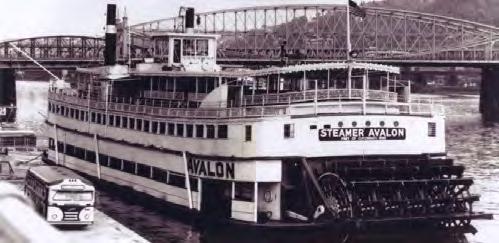
By J.R. Harris, Louisville
This story is about a 17-year-old who, in 1954, climbed up the side of the Avalon, which is now The Belle of Louisville Back in the mid-’50s, The Avalon was used to put on shows up and down the Ohio River. At one stop, I saw 10 tap dancers wearing cancan skirts, dancing to popular routines one could see in New York City or New Orleans. I
By Doris Cella, Murray
In the fall of 1953, my father contracted the mumps. Terrified they would “fall on him” (only later did I learn the possible consequences of his illness), he was in bed for six interminable weeks. But the Jersey cows kept right on producing milk on their 5 a.m. and 5 p.m. schedule oblivious to their master’s terror that he might never produce again.
At 13 and the oldest of his three offspring, I got up at 4:30 a.m. and sleepily headed to the barn. There, I shoved stubborn cows weighing many times my weight into individual stanchions, while dodging their swishing tails. Being hit in the face by a cow’s tail was like being hit with a bristle brush.
Next came attaching the automatic milkers, a task requiring dexterity and a gentle touch to avoid being kicked in the face or sprayed with the contents of their digestive system. Minutes later, I emptied the heavy milkers, teeming with white foam, into 5-gallon pails to be
don’t remember what the charge was, but Avalon anchored close to boat landings, and townspeople watched shows without boarding the boat. A comedian introduced the acts before the feature show of cancan dancers. Warm, dry weather was the key to draw a crowd of people.
Two crazy teens—my friend and I—hatched a plan to use my friend’s dad’s motorboat to go down the river from Russell, Kentucky, to Hanging Rock, Ohio, which was about 5 miles. We cut the motor and pulled up alongside the Avalon. I didn’t have a plan or know what I was going to say. When you are winging it, you just do it.
We were almost to the top deck when a girl stepped out and threw out a washbowl of soapy water. We both were covered with bubbles and dirty water! To add to our already-doused plan, we ran out of gas on our way back, a mile from our dock. Using a paddle and a water ski, we made it back. This event took place 70 years ago, but when I see The Belle of Louisville today, I remember what it looked like when it was the Avalon
transported on foot to a 100-gallon cooler in the nearby milk house. Once milking was completed, washing up remained a thankless task that required more heavy lifting and scrubbing and a final sweep of the milk house floor.
Wet and exhausted, I returned to the house to change for school. By the time the Hiseville (Barren County) school bus lumbered up the road to our front door, my day was three hours spent! Upon returning from school in the afternoon, I repeated the milking process and then fell into bed to rest my weary, aching muscles. I continued this routine twice a day, seven days a week. Even my cherished habit of sleeping in on Saturdays was disrupted.
Although I had been longing for more independence, I became, instead, a slave to the Jerseys’ endless schedule— eating, producing and resting, blissfully unaware of the trauma my father’s mumps had created in our lives.
Eventually, he resumed the life he had chosen and enjoyed, and I returned to my regular routine, but with a different attitude. Forced to make an impromptu transition into adulthood, I acquired a habit that has served me well: When there’s work to be done, regardless of the circumstances, just do it!
By Don J. Dampier, Georgetown
Carlisle in Nicholas County had an active Boy Scout troop during my youth in late 1940s and into the ’50s. The Carlisle Boy Scouts had been organized as Troop #15 on Feb. 9, 1943, as part of some 18,000 Scouts and Explorers registered in Kentucky. At 9, I joined the Cub Scouts. Then at 12, I became a full-fledged Boy Scout. My mom took me shopping in downtown Lexington to get the uniforms.
In May 1947, older Explorer Scouts had razed a donated clapboard-covered log barn on the farm of W.N. Young, brought the numbered logs, and resurrected the barn at the corner of East Main Street and East Union Road, adjacent to the Carlisle High School football field. The project was partially funded by the Carlisle Rotary Club. A local mason donated his time and skills to supervise the boys while they constructed a fireplace inside. The small building had a concrete floor, electricity and a bathroom and served as the Scout meeting house for many years. It was torn down, probably due to high water, in the late 1950s.
I remember a wintry night during one of our weekly meetings, sitting among some dozen or so fellow Scouts, awaiting the opening exercises by our longtime Scoutmaster Everett M. “Smitty” Smith. Each of us took turns adding a log or two to the fire, listening to the sounds of the log fire in the cozy confines of our very own log cabin meetinghouse.
Upon the entry of Assistant Scoutmaster Kenneth “Scout” Campbell, Scoutmaster Smith had us all rise to recite the 19-word Pledge of Allegiance. It would be a few years hence to Flag Day of June 14, 1954, and the addition
By Carol Ingle, Scott County
When fall rolls around, I think about gathering fruit. We had family who had apple, pear and peach trees and grapes. With the wild grapes/muscadine that we made jelly, jams and preserves and canned and dried the fruit. I remember cutting up apples and drying them on tin. We dried peppers, too. We’d string up dried fruit and peppers. My granny always had strings of tiny peppers in the kitchen.
We also made straps or leathers. These were fruit cooked down with no sugar at all, then poured out on flat trays, tented with cheese cloth and dried in the sun. When the leather was was ready, my granny used scissors to cut it into strips, which were hung. We ate them for as long as they lasted. I loved the peach straps.
I remember The Watkins Man (a door-to-door salesman) showing up at our door just before canning time,
of the words “Under God” to become the modern-day 21-word pledge.
At one meeting, Scout Campbell, toting a bulky feed sack, asked, “Is there any of you boys that would like to learn to box?” I immediately shot my arm up, “Yes, I would!” To that, Scout, a right-handed redhead who had boxed in the Golden Gloves, probably in both the welterweight (135-147 pounds) and middleweight (148160) classes, reached into his bag and tossed in my direction a worn pair of boxing gloves, which I adeptly caught. “Good, quick hands ... that’s very important!” Kenneth then pulled out a used punching bag ready to mount and a booklet, The Manly Art of Self-Defense.
Scout followed up with visits to my house to teach me boxing fundamentals while assisting my mom in stuffing the feed bag with old fabrics and papers, creating a “body bag,” which we mounted along with the “punching bag.”
Mom also found and mounted a full-length mirror so I could shadow box. Dad supplied me with extra pairs of boxing gloves, and, a year later, a 100-pound set of barbells. Our stand-alone garage became a makeshift gym that we called Donnie’s Den. And that is how I got interested in the art of amateur boxing.
Because of backyard boxing, I maintained good physical conditioning and confidence to keep bullies at bay. I stayed active in the Boy Scouts with close buddies Jackie Shepherd and my cousin, Bobbie Anderson, earning merit badges, training younger Scouts, camping, hiking and staying at our Troup #15 Camp Blackhawk on the Licking River, as well as Camp McKee and Camp Offutt. I advanced to the rank of Life Scout, but later earned a driver’s license and became interested in the opposite sex.
Thanksgiving and Christmas. He seemed to know that spices or vanilla would be needed. My granny bought several things from him. She always bought vanilla, lemon and almond extract. She bought pickling spices, cinnamon and nutmeg sometimes. We raised our own dill and sage. He had all kinds of things with him and let us smell them.
My biscuits never tasted like my granny’s. She had a big crock bowl she made biscuits in. The bowl always had flour in it. She never measured anything. She put the flour in the bowl, poured her powders in the palm of her hand, then sifted the flour and powders together. She made a well in the center of the flour, reached into the lard can to get get a clump of lard, then poured the buttermilk or sweet milk in and squished it between her fingers. She slowly added the flour in the mixture until it was a big ball. She took the ball and put it on a big cutting board covered in flour. She had an old creamer can that stayed in the flour to cut the biscuits with
By Bobbie Smith Bryant, Jefferson County
The sight of a tractor making its slow and deliberate way through a freshly plowed field of tobacco here in Western Kentucky is somewhat rare nowadays. Our times, they are a changin’, particularly since the 2004 Tobacco Transition Payment Program. While tobacco farming has evolved, many of the old customs remain the same.
Producing a tobacco crop has always been dictated by the seasons. A typical crop can take more than 300 hours of labor per acre. That labor includes many steps and lots of workers to set, hoe, cultivate, cut, house, fire, strip and finally take it to market. As some of the old folks were known say, “Tobacco is a 13-month-a-year job,” because, in the past, you started a new crop before you were finished with the previous year’s crop.

Every aspect of a tobacco crop requires hands-on labor. While modern techniques have lessened some of the more laborious tasks, such as worming and hoeing, tobacco still requires many hands touching each plant multiple times.
As a young girl growing up on our farm in Calloway County in the 1960s, my jobs included helping pull plants, riding the setter and hoeing. Thank goodness, the more physically demanding tasks of spiking, cutting and housing generally were left to the boys and men, though I did straddle the beams up high in the barn one year, much to the dismay of my mother.
Back then, being “a good hand” was a coveted title. The term was used for boys and girls, men and women, no matter the age or skin color. We young ones were taught and encouraged by our parents and elders as we labored alongside them in every aspect of producing a crop.
If there can be a favorite part to growing tobacco, I’d say mine was the stripping. Let me be clear:It’s not the work that was favored but the fellowship that went along with it. Stripping crews usually were a different bunch than the rest of the labor force. In my limited experience, older workers did the stripping, and younger people did the splitting, hanging, housing and firing under the watchful eye of more practiced workers.
My grandparents were involved in our family’s farming operation up into their elderly years. I remember them being in the stripping barn when I got home from school.
Typically, they and a few other retired neighbors lined up on a variety of stools, chairs, buckets and the like, pulling leaves from each stalk, grading them as they went. They were rhythmic and sure, tying a single, folded leaf around the stems of a handful of dark leaves to create a “hand of tobacco.”
While this constant motion of stripping and tying ebbed and flowed, the conversation rarely stalled. They told tall tales, shared recipes and an occasional joke, intermingled with local news and the politics of the day, along with recollections about our neighbors, friends and family from years gone by. I was happy to be in their midst, watching, listening and doing, hoping someday I’d make a good hand.
I’m sure my recollections have clouded over time. Yet, my memories of the stripping barn are not so much of how difficult and tiring the work was, but more of a warm remembrance of how I learned to work and to enjoy the work no matter how dirty and grueling. Even more, I came to appreciate the work of others.
The lessons I learned on the farm have stayed with me. I’m grateful for those elders who took the time to show me what to do, corrected me when I fumbled, and encouraged me to keep trying as I worked my way toward making a good hand.
This article is an excerpt from a previously published story titled, “All Hands Are Well,” Murray Ledger & Times, May 28, 2020.
By Patti Grace, Lexington
In Bourbon County in the fall of 1946, Jimmy Shifflett got off the school bus and walked through the doors of the two-story Ruddles Mills Elementary School, beginning his education there in the fourth grade. He had moved to the area from Pennsylvania, where he had begun first grade with an ethnically diverse groups of students.
Jimmy’s father was a welder at the shipyards during World War II, and Jimmy attended school with Black children and Spanish- and French-speaking kids from several countries that had contributed to the American war effort. His family consisted of a mother, father, brother and sister at that time, and in Pennsylvania, they were in furnished government housing with electricity, water and indoor plumbing.
Here in Kentucky, the way of life was mostly farming— locals who owned small farms or were tenant farmers. Many did not have the luxuries that Jimmy was accustomed to. The water in his house came from a cistern, and there was electricity, but the house had only outdoor bathroom facilities.
About 200 students attended the Ruddles Mills School through grade eight, with about 25 students in each class. Jimmy’s school in Pennsylvania had nearly twice as many students. The cafeteria of Ruddles Mills School was in the basement, and there were boys’ and girls’ outhouses just outside the main building. There was a unique feature of a slide beginning on the second floor and running to the ground on the right side, facing the building, which caught my eye as Jimmy showed me his boyhood school for the first time. The slide was meant to be used as a fire escape, but my mind could see the fascination the youngsters could have with that building feature.
I was told by Johnny Wyatt and Jimmy that the principal, Mr. Richey, diligently monitored that opening to the slide on the second floor in the music room. Johnny once was caught sliding down the fire escape slide. The only discipline he remembered for the infraction was a severe tongue lashing.
Patsy Turner Fightmaster joined Jimmy in the fourth grade, and Mrs. Harney was their fourth-grade teacher. They are still friends today. Along with Johnny, who had begun at Ruddles Mills Elementary in the first grade, they all attended until the eighth grade and graduated together. In 1940, Ruddles Mills Elementary School ceased having high school, and students were transferred to Millersburg

High School and Bourbon County High School. Their teachers through the years were Mrs. Harney in the fourth grade, Mrs. Clark in the fifth grade, Mrs. Richey in the sixth grade, Mrs. Rice in the seventh grade, and the principal and eighth grade teacher was Mr. Richey.

The school closed its doors in May 1989. Patsy recalled that outdoors on the playground the students played marbles, swung on the swing set, played softball and jumped rope. When recess was indoors, the girls mostly played jacks and card games.
Patsy lived in Shawhan, and Jimmy lived about 4 miles from school. They rode school buses, but Johnny usually walked or ran because he lived only about a mile from school and was able to get to school more quickly on foot than by bus. He normally worked on the family farm before leaving for school in the mornings, and this gave him a little additional time to work.
Johnny recalled an incident when student Wanda Turner once pinched him. Johnny got caught pinching her back and had to stand in the corner on his first day of school!
Johnny enjoyed learning about music. Mrs. Crombie, the music teacher, brought small hand instruments that any student could enjoy learning, such as the triangle and tambourines.
The current owner of the building, Brad Wallace, found some marbles outside and notes stuffed in radiators during the remodeling of the property. He and his family live there now and have a business called Cappy’s Caramel Corn. You can can follow them on Facebook.
If anyone has pictures of the original classrooms, stables and/or gymnasium, please share them with him. He would be so pleased to add them to his collection.
Partially reprinted with permission from The Bourbon County Citizen
By Roger L. Guffey, Lexington
Native Americans and settlers of Kentucky have lived intimately with its wildlife throughout its history, and the various critters that live in the state are inextricably woven into the lives and culture of the people. The skunk is undoubtedly the most nefarious denizen of the state and is particularly familiar to the people in the Appalachian Mountains.
Skunks are members of the weasel family, and Kentucky has two native species: the striped skunk, Mephitis mephitis, and the eastern spotted skunk, Spilogale putorius. The striped skunk is the image of a skunk most people know.
The word “skunk” is derived from an Algonquian word meaning “He who squirts or urinates.” The distinctive blackand-white striped fur is an example of what biologists call aposematic coloration, which warns predators to steer clear of its owner.
about one experience she and her husband had with skunks. One summer evening, their hound had treed an animal up on the mountain, and they decided to investigate. They found the dog barking and pawing at the entrance to a den, and they made the fateful decision to “twist out” whatever critter was in the hole.
Hunters often cut a slender sapling and split one end into quarters, which are splayed open. The stick is inserted into the hole and twisted until the stick entangles the animal’s fur so it can be extracted. Unfortunately, their quarry was a striped skunk that was less than thrilled to be so rudely treated. The hunters beat a hurried retreat without bothering to untwist the skunk from the stick.

Skunks are nocturnal, and any predator that ignores the black-and-white stripes will be dowsed with an noxious yellow sulfur-based secretion that is extremely difficult to remove. Great horned owls are the most common predators of skunks for two reasons: owls are nocturnal and cannot smell the foul odor.
Cynics claim that “love stinks,” so perhaps it is appropriate that Valentine’s Day occurs in February, the primary mating season for skunks. That is why highways are littered with skunk carcasses in that month. Loudon Wainwright III immortalized the plight of motorists who run over a dead skunk in his song “Dead Skunk”:
“It ain’t no flower, it ain’t no rose, roll up your window and hold your nose.”
Gestation in striped skunks lasts about 59 to 77 days, and the kits are born in May or early June. The kits are blind for three weeks and are weaned after 42 to 56 days. I was lucky enough one night to see a mother skunk leading her five kits in single file across the road while she was teaching them to forage. Most young skunks do not survive their first year, but those that do have a life expectancy of about seven years.
Dr. Roger Barbour, a University of Kentucky mammologist, told me that an intrepid person can pick up a skunk by the tail without getting sprayed if he can pick the skunk off the ground quickly enough before it can use its hind legs to squeeze the scent glands. He suggested that you be quick and accurate in your attempt.
Most Kentuckians from the mountains have stories about skunks. My favorite high school teacher told us
Skunks often carry rabies, and any skunk encountered during the daytime may be a carrier. One day, my mother saw a skunk toddling along the far side of the garden while she was washing dishes. She called for my father to dispatch it as a precaution. My father grabbed his shotgun and ran over to kill the skunk. Alas, he was so close to the skunk that the shotgun pellets did not spread enough to kill it. Its only injury was a bloody nose until my dad clubbed it with a two-by-four.
Skunks inhabit most of North America. When I was in graduate school at the University of Illinois at UrbanaChampaign, one of my professors had a legendary encounter with a skunk. The professor researched the ecology of meadow mice and had maintained a large trapping grid to track their movements in a field about 5 miles from Urbana. The traps had to be checked daily because hungry raccoons had learned to reach into the small box traps and extract the mice for a meal. They had become such a problem that he set up live traps to catch the raccoons so he could he relocate them.
On one January day when the snow was knee-deep, he found one of the live traps had captured an animal. He picked up the trap to eye level to remove it but saw that it was a skunk, not a raccoon. The terrified skunk bombarded him with spray from the waist up. If he had not been wearing his glasses, the spray would have blinded him. Somehow, he managed to drive back to the campus safely, but his expensive goose-down coat was ruined.
The most famous skunk in the animated cartoons is Pepe Le Pew, who constantly is wooing a striped female cat with amorous intentions. Another is Flower in the movie Bambi
An infamous joke asks, “What is the difference between a dead skunk and a dead lawyer in the road?” Answer: There are skid marks around the skunk.


By Joe Wall, Mayfield
My father, Joe B. Wall, was born in Hickman on June 21, 1930, and grew up in Cayce in Fulton County. He died Sept. 6, 2012. Most of his family, including both of his parents, went to the University of Kentucky.
Dad had a stellar basketball career at Cayce High School from 1945-48 and holds the all-time high scoring record from 1948 to this day. The only team to beat Cayce during his senior year was Brewers Redmen High School, which went on to win the Kentucky High School Championship in 1948.
Dad tried out for the UK basketball team in 1948, but he did not receive a scholarship due to his bad knees. He said he probably would have ridden the bench, as that was the era of the Fabulous Five. Dad did play college basketball at Holmes Junior College in Mississippi for two years and walked on at Georgia Tech. But again, his knees caused him to be cut from the team.
He graduated with a degree in mechanical engineering and went to work and married my mom, Carole Burkhart, from Paducah.
Joe B. Wall stood 6 feet, 3 inches tall and weighed 160 pounds during his basketball days; below, letter to Wall from Coach dolph Rupp.

Businessman Andrew Carnegie amassed his fortune primarily through strategic investments and acquisitions in the steel industry. As a philanthropist, he had a strong interest in education and self-improvement. His goal was to make knowledge accessible to everyone.
In 1881, he began promoting the idea of free public libraries. These libraries, known as Carnegie libraries, were built with his generous donations.
By the time the last grant was made in 1919, there were 3,500 libraries in the United States, nearly half of them funded by Carnegie. He believed in using wealth for the community’s benefit and saw libraries as a means of selfeducation and empowerment for all.
At least 22 of these buildings still exist, and some are still libraries.
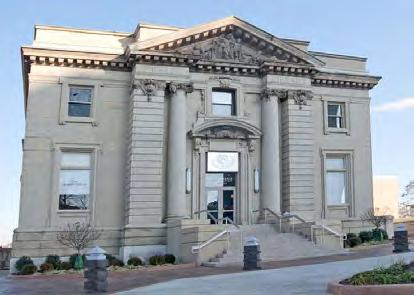
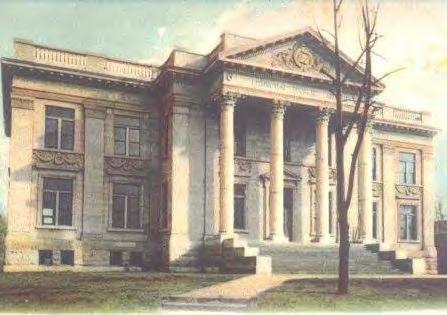

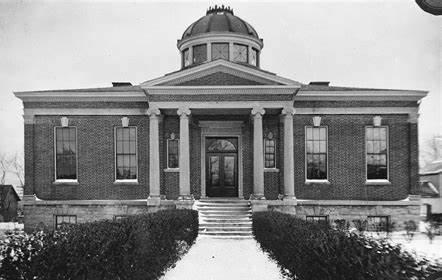

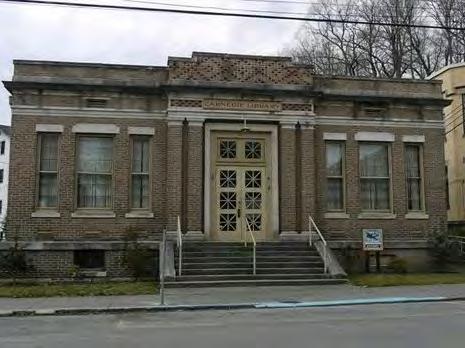
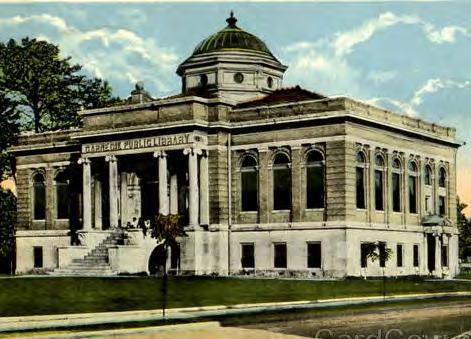
By David Morse, Frankfort
Shay locomotives are named for Ephraim Shay, their inventor. After serving in the Civil War, he owned a logging operation and sawmill in Michigan. At the time, logs were hauled out in the winter on ox-drawn sleds. Looking for a way to haul logs year-round, Shay experimented with using steam locomotives to haul log cars out. He soon discovered that regular locomotives could not handle the rough track, sharp curves and steep grades of the logging lines. Experimenting with his own design of steam locomotive, he came up with what is known as the geared locomotive, which is the closest railroads have come to an all-terrain vehicle.
being powered, enabling the locomotive to climb steep grades and pull heavy loads. The pistons, camshaft, drive shaft and differentials can be seen in this photo.
In 1878, the Lima [Ohio] Locomotive Works received a license to build Shay locomotives. Shays proved so successful that two competitors, Climax and Heisler, built their own design of geared locomotives. The last Shay was built in 1945.
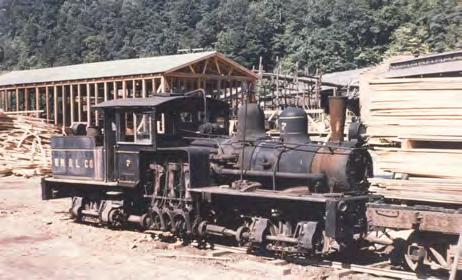
County).
A geared locomotive has two or more independently mounted 2-axle trucks. Each truck can pivot freely and flex independently of the other truck or trucks. This allows the locomotive to handle a rough track. Some logging companies even used tracks with rails made of logs.
Shay’s steam pistons were mounted vertically on the right-hand side, and that drove a crankshaft. The crankshaft turned drive shafts that ran down the side of the locomotive. At the end of each axle was a differential to transfer power to the axle. This resulted in every wheel on the locomotive
Reach 120,000 readers with classified advertising available in Kentucky Explorer. Classified ads $50 per issue (up to 25 words). For more information, contact Deborah Kohl Kremer at deb@kentuckymonthly.com.
BURLINGTON ANTIQUE SHOW — More than 200 dealers, 10 minutes south of Cincinnati. Sunday, Sept. 15, 7 am-3 pm, rain or shine, 513.922.6847, www.burlingtonantiqueshow.com.
KENTUCKY EXPLORER MAGAZINE — We have a select number of back issues of Kentucky Explorer from 1986-2000. Back issues are $5 plus postage. If you are in search of a certain issue or are interested in adding issues to your collection, please contact Deb at deb@kentuckymonthly. com to see if it’s available.
The Shay in the photo was built in 1911-1912 for the Elk & Little Kanawha River in Gassaway, West Virginia, as a 36”-gauge narrow gauge locomotive.
She was later sold to the W.M. Ritter Lumber Company, which used her on the Big Sandy & Cumberland Railroad between Devon, West Virginia, and Grundy, Virginia. In 1958, Ritter moved her to Daisy, in Perry County, and regauged her to 42” gauge for use around the mill. She worked along the Leatherwood Creek until 1962.
After the Daisy Mill was sold, her ownership changed a few times. In 1988, she was sold to Roaring Camp & Big Tree Railroad in Felton, California. At last report, she is stored and not in operation.
The closest place to Kentucky to see these locomotives in action and to ride a train pulled by one is at the Cass Scenic Railroad State Park in Cass, West Virginia, wvstateparks.com
WANTED — Paying cash for large diamonds; collections of vintage wrist and pocket watches; gold and silver coins; sterling flatware and serving pieces; gold and silver jewelry; collections of arts and crafts and pottery; antique advertising signs; antique walking canes; pocket knives; collections of antique guns and swords; military collections; early handcrafted crocks and jugs; and musical instruments. Call Clarence, buyer for more than 35 years, 606.531.0467. (F-D)
WANTED — All types of antiques and collectibles. Top prices for gold, silver and costume jewelry. Scrap gold. Gold and silver coins. Wrist and pocket watches. Collections. Early post cards and fountain pens. Civil War swords and other military items. Vintage toys. Pocket knives. Lighters. Old eyeglasses. Pottery and stoneware. All types of railroad items. Advertising signs. Handmade quilts. Marbles. Jars. Much much more. Complete and partial estates. Call Clarence, buyer for more than 30 years, at 606.531.0467 (F-D)




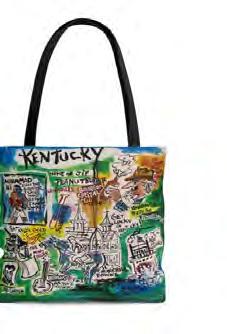

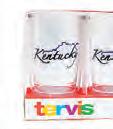






Kentucky native James W. Miller’s King of the Gunrunners is part novel and part history set during the years before the SpanishAmerican War. The author emphasizes the role of John D. Hart, a Philadelphia fruit importer, in capturing the the support of United States citizens for the Cuban rebels opposing the inept and harsh rule of the Spanish.
The book is the story of seagoing merchants from New York to Key West who began by importing prized bananas from Cuba and the West Indies. They rode the waves of a fad for the banana until the Panic of 1893 destroyed the taste of most U.S. citizens for the fruit.





Cuban revolutionaries living in the U.S. saw an opportunity. They could carry men and war materials to the revolutionaries in Cuba and bring bananas back to the East Coast. That started a triangular battle among the “filibusters” or gunrunners, the U.S. government, and the Spanish in Cuba and the United States. Gunrunners sought to evade U.S. and Spanish forces at sea and fought in the courts to keep their vessels and stay out of jail.
By Dr. Lindsey Apple
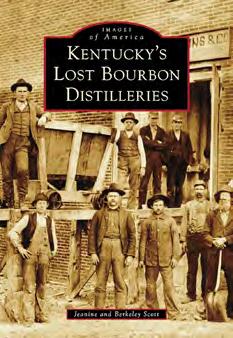
While bourbon’s enormous popularity has resulted in new distilleries popping up all over the state, today’s number of bourbon producers doesn’t hold a candle to the hundreds of distilleries that existed in Kentucky from the late 1700s until Prohibition in 1920.
Jeanine and Berkeley Scott of Paris, the authors of Kentucky’s Lost Bourbon Distilleries, spotlight these defunct distilleries in their book. Among the “lost” producers are some companies with which today’s bourbon drinker might not be familiar, but they were leaders of their time. These include McKenna Distillery, Coon Hollow Distillery and Bond’s Mill.
The book features fascinating photos, some dating back to the 1800s. Each page highlights longforgotten distilleries, their employees, newspaper ads and memorabilia that contribute to telling the story of Kentucky’s native drink.
The Scotts, who are journalists and historians, are no strangers to the bourbon industry, as The Kentucky Bourbon Trail is among their several previous books.
By Deborah Kohl Kremer
Distilleries

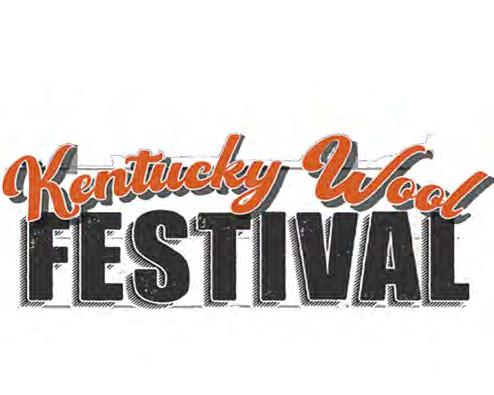



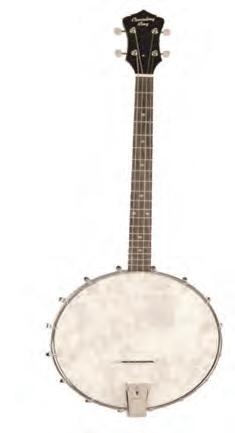




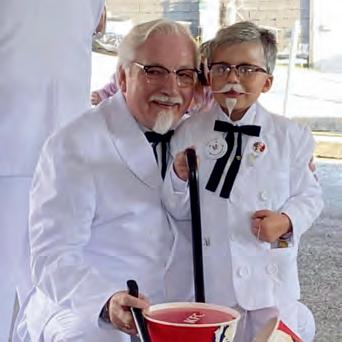


BY BILL ELLIS
Kentucky Monthly is always full of stories, commentary, advertisements and pictures evoking a Kentucky theme.
Where is the place that you feel most at home, where “sense of place” is so overpowering that you want to belong there forever?
Your “sense of place” is determined by several factors. Kentucky is a diverse state. You might consider yourself “Southern” if you live in Western Kentucky, or more “Midwestern” if you live in Northern Kentucky. What of Appalachia? Are you a “mountaineer?” And is it Looeyville or Looavul?
You might have been born outside the Commonwealth, perhaps even in another country. Over time, Kentucky has become more cosmopolitan, as immigrants have joined us from other countries. I don’t recall a Chinese, Mexican, Italian or other identifiable “foreign” restaurant when I was a kid.
Now, my wife, Charlotte, cannot go a week without a chicken chimichanga, and I love huevos rancheros and prefer corn to flour tortillas. A vegetable-filled calzone suits me often, but I still love soup beans and cornbread, and don’t forget the onion and maybe a big spoonful of homemade relish.
. . .
Over the course of my teaching career, I found that students who grew up in service families and lived abroad or on United States bases for much of their lives often had no identifiable accent, and they did not
identify necessarily as Kentuckians.
Is Kentucky now as cosmopolitan as any other state? Perhaps it has something to do with music. I grew up listening to Renfro Valley on the radio and then Elvis Presley, but now, I enjoy a classical performance of a full orchestra booming out “Finlandia” or an organist who can play Bach’s “Toccata and Fugue” with all the stops out and the shutters open. Don’t get me wrong—I can sing lustily while listening to “Wolverton Mountain,” “ ’cause Clifton Clowers has a pretty young daughter.” So what does that make me?
Where is the place you were born and grew up? Is it the “old homeplace” that continues to mean so much in Kentucky lore? I do not have such a place.
The Ellises in my background appear to have been scattered from Indiana to Kentucky, with my Ellis grandparents living as tenant farmers for much of their lives. My Stratton grandparents were tenants until they finally bought the old homeplace, which made them the first generation of my family on Buzzard Roost Road in Shelby County.
My background is Northern European as testified to by a blood sample, with the usual smidgen of Neanderthal thrown in. You can tell that is so by my fair complexion and once-red hair. Members of the Campbell side of my family were swept out of Scotland with the “clearings,” as landlords switched from crops to sheep.
. . .
I was born in Danville but grew up on Snow Hill, just outside Shelbyville on U.S. 55, and have lived almost all my life in Kentucky. That is the place I still identify with most. More than 65 years later, I can still drive by the little house where I grew up from 1948-1958 and wistfully recall so much.
I was lucky enough to receive a Fulbright Grant in 1989 to teach at Massey University in New Zealand. I taught an oral history class and helped found a program to collect oral histories of individuals. That was back in “the old days” of tape recordings. We lived in a small house that the Kiwis called a granny flat.
I look back at those days and recall how comfortable I felt living in that time and place. We bought an old fourdoor Triumph and drove thousands of kilometers to the oceans on both sides of the North Island, visited small towns, and ate in tea rooms, never missing out on the fresh scones.
When we last returned to New Zealand in 2014, it seemed everything had changed. It was more modern.
Where do you feel most comfortable? Do you live in a big city? A small town? In the country?
Here I am a bona fide American citizen, and, as the song goes, “I’m proud to be an American.” Yet I constantly grouse about politics and changes in the country I do not totally agree with. I reckon that qualifies me as an American.
Readers may contact Bill Ellis at editor@kentuckymonthly.com




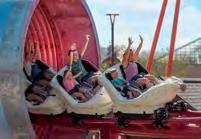



BY GARY GARTH
With summer’s sweltering heat and humidity likely to bleed into September, it might not feel like hunting season, but it is.
Squirrels are legal now. Dove hunting opened Sept. 1. Teal, wood duck and Canada geese (early season); Virginia and sora rail, common and purple gallinule and snipe seasons open later this month.
Deer season for archers opens Sept. 7. Whitetail deer are Kentucky’s marquee and most sought-after game animal. Elk would likely claim that spot if more were available. The state’s elk reintroduction program has been an astounding success, and the free-ranging herd has grown to about 10,000 animals across the 16-county Eastern Kentucky elk zone. But elk hunting is by quota draw permit only, and there is no shortage of applicants. An elk tag is hard to come by.
Kentucky’s deer herd, by contrast, numbers more than 1 million animals and is thriving. The surging deer herd also is a product of wildlife recovery fueled by careful conservation practices and good management. Deer hunting popularity has grown with the herd. For the 2023-2024 season, hunters checked 141,065 whitetails. If one of every three hunters were successful (a generous estimate), that would put hunter numbers around 425,000. I don’t hunt deer as often or as aggressively as I once did. This could be a function of age (I recently reached 69), but I doubt it. My enthusiasm has not waned, but like many hunters who have been at it for decades, I’ve become more selective. That doesn’t mean I’ve become so set in my ways
that I’m not open to new ideas. Recently, Ethan at Gunpowder Inc., a PR/marketing company, invited me to try a Ravin Crossbow. I declined. I’m not much of an archer and had never hunted with a crossbow.
Then I thought, “Why not try something new?” Although there is nothing new about crossbows. They outdate the Bible.
The Ravin R10X that soon arrived is a technological marvel. It shoots fast (around 420 feet per second) and is compact (33 inches long), lightweight (6.8 pounds) and durable (nylon fiber stock and composite limbs). It is quiet, firm, accurate, easy to load and fun to shoot. And it comes with a quality scope.
While the R10X is a piece of welldesigned, finely tuned hunting equipment, the crossbow itself is an ancient weapon, steeped in legend. According to Crossbow Magazine, they are thought to have been developed in China around the 7th century B.C. Those first bows were likely simple but effective with a wooden stock, bamboo arrows (called bolts in modern crossbow lingo), and a rough but effective trigger mechanism.
A few centuries later, the technology had moved westward, and crossbows were introduced throughout Europe and the Mediterranean, by which time their effectiveness in war had been proven in China. When it was discovered that an arrow launched from a crossbow could pierce armor, crossbows altered European warfare tactics. So effective was the crossbow as a tool or weapon, some segments of the early Christian church attempted to ban them.
The arrival of gunpowder pushed crossbows off the battlefield and into near obscurity. But they avoided the dustbin of history and have a made a comeback largely via the hunting and sporting community.
A crossbow is essentially a bow mounted on a frame: a stock, bow, string and trigger mechanism. Much has been fine-tuned, but little has basically changed.
Some hunters in the traditional archery community once looked upon crossbow hunting with a slight air of disdain. Some probably still do. But Kentucky’s crossbow deer-hunting numbers are growing. For the 2013 license year, the statewide crossbow deer kill was 3,311. A decade later, it had swelled to 12,501, but some of the increase must be attributed to an expansion of crossbow season dates.
For the 2024 Kentucky deer campaign, the crossbow season opens Sept. 21 and runs through Jan. 20. The senior/youth crossbow season opens Sept. 7. See you in the woods.
Whitetail deer aren’t the only game available to Kentucky’s hunting community. Hunting opportunities abound for small game, upland game, waterfowl and more. Check the Kentucky Hunting & Trapping Guide and the Kentucky Hunting Guide for Waterfowl for details. Both are available at fw.ky.gov and wherever sporting licenses are sold.
For additional information, including public property open to hunting, contact the folks at the Department of Fish and Wildlife Resources at 1.800.858.1549. They’ll be happy to help.
Little plants are getting big—big as in more popular.
I’m talking about bonsai, the Japanese art of growing and shaping miniature trees in containers. Bonsai (pronounced “bone sigh”) is a combination of horticultural skill and artistry that is growing in popularity in the Commonwealth.
At the Waterfront Botanical Gardens in Louisville, the next phase in the development of the gardens is a Japanese garden that will contain a bonsai house and outdoor “room” to display bonsai. The state has pledged $4 million to that project, and the city of Louisville has kicked in another $1 million. The gardens need to raise about $3 million more to break ground, said Megan Bibelhauser, director of communications and marketing for Waterfront Botanical Gardens. Groundbreaking will take place later this year or early 2025, Bibelhauser said.
Waterfront Botanical Gardens hosted its second annual bonsai weekend in August. Last year’s event atracted more than 2,000 attendees. Members of the Greater Louisville Bonsai Society are helping care for a rotating bonsai display at the gardens open to the public viewing.
The Central Kentucky Bonsai Society will host a bonsai show Sept. 20-22 at Michler’s Florist, Greenhouses & Garden Design in Lexington. The show opens Friday, Sept. 20, at 6 p.m. Saturday hours are 10 a.m.-7 p.m., and Sunday hours are 10 a.m.-4 p.m. The show is open and free to the public.
The Central Kentucky Bonsai Society has about 60 members, and around 200 people get the club’s
newsletter, society president Tim Weckman said. The group meets at the Emmert Farm in Lexington the third Saturday of every month. At each meeting, a speaker explores some aspect of bonsai.
“You can read books or find a wealth of material on the internet, but meeting in person seems to help people make more progress more quickly,” Weckman said.
Weckman, who owns Berea Bonsai Studio & Nursery, describes the practice of bonsai as 80 percent horticulture and 20 percent artistry. The goal is to produce what looks like a full-size tree in miniature and to keep that tree shaped in an aesthetically pleasing way. The art of bonsai is thousands of years old; some specimens created in the 15th century still exist.
You can get a start in bonsai easily by purchasing a specimen already in progress, or you can make your own from nursery stock.
Not every tree is suitable for bonsai, Weckman said. A sycamore with its large leaves won’t do well as bonsai. Maples, especially Japanese maples, pines, hollies and junipers are good choices, he said. Many bonsai practitioners want native trees. In that case, bald cypress, eastern hemlock and hackberry work well, Weckman said.
Because the tree is going to grow in a small container, its roots must be kept juvenile, which means the large, woody roots have to be cut away before the tree is placed in the container. The goal is to keep a pad of feeder roots that feed the tree.

Because the tree has a pad of feeder roots rather than large, ligneous roots that would hold up a larger tree, wires are used to support the specimen.
The medium in which the plant grows must be well drained, so frequent, light watering is critical. Too much watering will cause the roots to rot. Nutrients must be supplied frequently. “It’s a lot like keeping a houseplant,” Weckman said. “You have to pay close attention to feeding and watering and sunlight and shade, depending on the species.”
As the tree “grows,” the trunk ages, but the leaves and roots stay young. The effect is an old tree in miniature.
Why bonsai?
“Too many people are cut off from the natural world, and it’s a way of reconnecting with nature,” Weckman said. “It’s engaging and calming and a way to focus away from the day-to-day.”
For more information, visit the Central Kentucky Bonsai Society at bonsainut.org or the Greater Louisville Bonsai Society at louisvillebonsai.org or at its Facebook page, Greater Louisville Bonsai Society.
1 2 3 4
Grand Rivers Arts and Crafts Show
Little Lake Park, Grand Rivers, through Sept. 2, 270.362.0152
8
Jazz at the Filson: The Dick Sisto Trio
The Filson Historical Society, Louisville, 502.635.5083
Burlington Antique Show
Boone County Fairgrounds, Burlington, 513.922.6847
DAY
Tea Tuesday
Waveland State Historic Site, Lexington, 859.272.3611

Stephen M. Vest Book Signing Of George Graham Vest Paul Sawyier Library, Frankfort, 502.352.2665
Carbonaro: Lies on Stage RiverPark Center, Owensboro, 270.687.2770
Steven Curtis Chapman in Concert
Mountain Arts Center, Prestonsburg, 606.886.2623
Ongoing Kentucky Folk Art
Kentucky Museum, Bowling Green, through June 30, 270.745.2592

Detail of painting from Set Ablaze: Paintings by Debra Lott exhibit
Author Frank Bruni
The Gertrude Polk Brown Lecture Series, Bomhard Theater, Louisville, 502.584.7777
Violinist Eunice Kim Glema Mahr Center for the Arts, Madisonville, 270.821.2787
Presents Dynamite & Rampage Rupp Arena, Lexington, 859.233.3535
Pauly Short Live
Paramount Arts Center, Ashland, 606.324.0007
Old Crow Medicine Show Jubilee Tour
Corbin Arena, Corbin, 606.258.2020
Bourbon & Beyond Festival
Highland Festival Grounds, Louisville, through Sept. 22, 1-888-512-SHOW
Todd Rundgren in Concert
Louisville Palace, 1.800.745.3000
Ongoing Yayoi Kusama
Infinity Mirrored Room, Speed Art Museum, Louisville, through Jan. 12, 502.634.2700
World Chicken Festival downtown London, through Sept. 29, 606.878.6900
Ongoing Jerry Garcia: A Bluegrass Journey Bluegrass Music Hall of Fame, Owensboro, through March 30, 270.926.7891
Set Ablaze: Paintings by Debra Lott
Pyro Gallery, Louisville, through Sept. 29, 502.587.0106
Kentucky Bourbon Festival
downtown Bardstown, through Sept. 15, 502.275.8384
Corn Island Storytelling Festival
Oldham County History Center, La Grange, through Sept. 22, 502.222.0826
Marion County Ham Days
downtown Lebanon, through Sept. 28, 270.692.9594
Ongoing Tiny Pieces Vast Visions Exhibit
National Quilt Museum, Paducah, through Dec. 30, 270.442.8856
The Big Four Arts Festival
Waterfront Park, Louisville, through Sept. 8, 502.435.7602
Simon Kenton Festival
Historic Old Washington, through Sept. 15, 606.563.2596
Lee Greenwood in Concert
The Plaza Theatre, Glasgow, 270.361.2101
Bluegrass Festival
downtown Williamstown, 1.800.382.7117
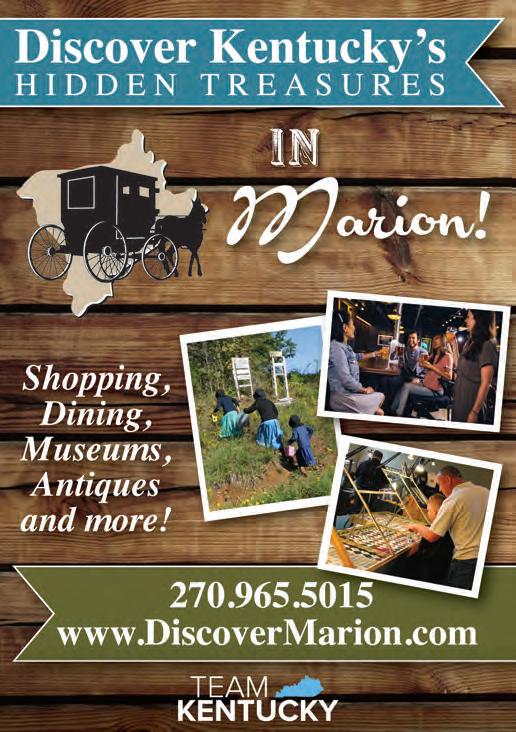


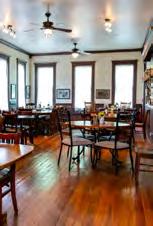

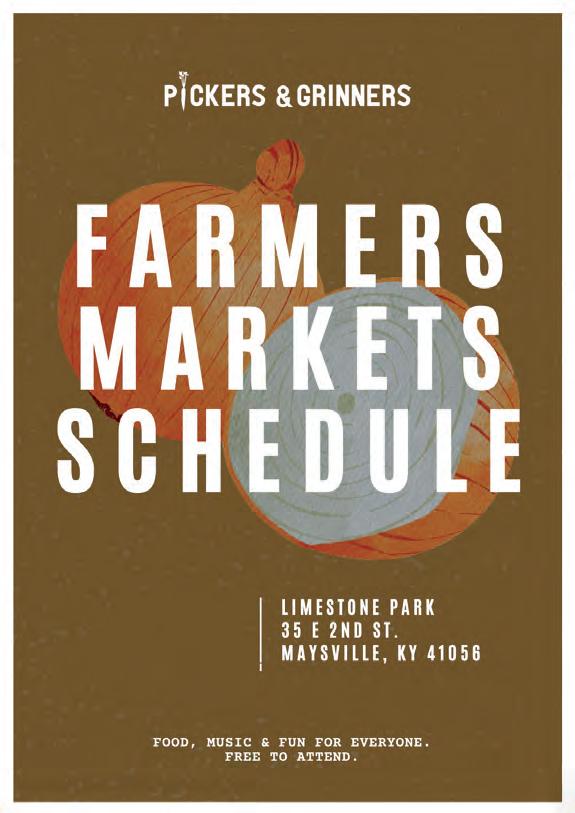





Shortly after I moved to Frankfort the first time, in the fall of 1989, I started working on a book about my only “famous” relative, George Graham Vest. I spent numerous Saturdays in the research room in the Old State Capitol Annex. I knew GGV was credited with coining the phrase “Dog is man’s best friend,” but not much else. Off and on for the next five years, I worked on piecing his life together, but then we moved away—chasing fame and fortune—and my research went into a box for another time.
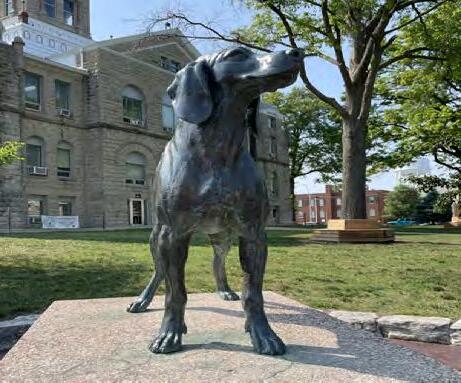
what true flood victims endure, such as those in Eastern Kentucky in July 2022. More than two years later, the long recovery continues.
Servpro was quick to respond. Once they mitigated the problem the best they could, we were left with boxes to explore and garbage cans to fill. We lost hundreds of books, thousands of photos, certificates and other mementoes.
A box marked “G.G.V.” was above the flood line.

STEPHEN M. VEST Publisher + Editor-in-Chief
When we returned to Frankfort in the late 1990s, I dusted off the box and restarted my research, but, one busy school night with three schoolaged kids running hither and yon, I was lovingly told my attention was needed elsewhere. In the kindest voice my wife could muster, she said, “I can’t keep up with these kids alone while you sit in here reading yellowed newspaper clippings. Help or get out!” Remember, she said it lovingly. Back into the box everything went, and my attention was focused—as it should have been—on raising our three (soon-to-be four) children.
Somewhere along the way, I mentioned to Gray Zeitz, the owner of Larkspur Press, that I had a project for him when I got my book finished. At Kentucky Crafted: The
Market, I told book publisher Doug Sikes I was nearly finished with a book that would be of interest to readers in both Missouri and Kentucky. For decades, he would ask, “How’s the book coming?” Every year, I’d say, “Almost there.”
Every so often, Russ Hatter, Frankfort’s historian emeritus, would call with some clue about G.G.’s life. I’d review it and file it with the other info in the box that moved from Frankfort to Myrtle Beach and Rock Hill, South Carolina, and back to a succession of three different Frankfort houses.
Late one night five or six years ago, in our current home, there was a snap, a crackle and a pop, followed by a swoosh, which, at first, went ignored. Several hours later, around 4 a.m., my loving wife discovered the snap, crackle and pop were caused by a burst pipe in the basement, which was quickly filling up with water.
Only people who have had a foot of water in their basement can understand the devastation water causes. I can only vaguely imagine
“You know,” my loving wife lovingly said, “this might be an appropriate time for you to get that box out and do something with it before it’s lost.”
So, I did.
Now, some 35 years after I started the project, the book is done and ready to share. On Monday, Sept. 23, at Frankfort’s Paul Sawyier Library— next door to the Vest-Lindsey House—George Graham Vest: The Life and Times of Dog’s Best Friend will make its debut. Sikes’ Acclaim Press is the publisher, and Zeitz, who is famous for his handmade books, has created a beautiful broadside of G.G.’s famous “dog speech.”
I don’t want to give away too much about the book here, but if you’re looking for a speaker who can talk about Kentucky before the Civil War, Missouri before Mark Twain, the Confederate government, post-Civil War America, the James-Younger Gang, the preservation of Yellowstone, Washington during the Gilded Age, Thomas Jefferson’s lasting impact on America, Native American relations, or man’s love of dogs, I can help.
Vest can be contacted via his email, steve@ kentuckymonthly.com

